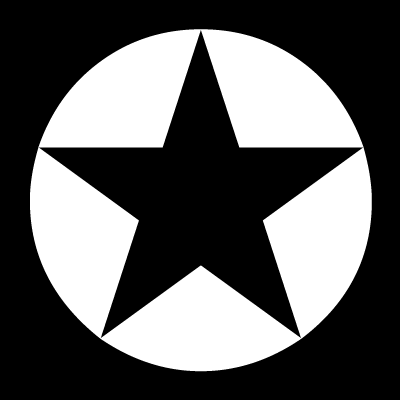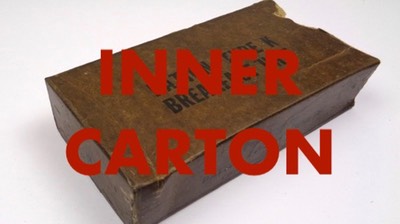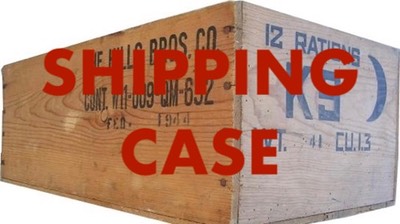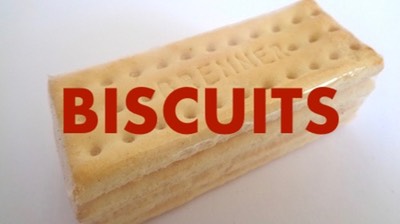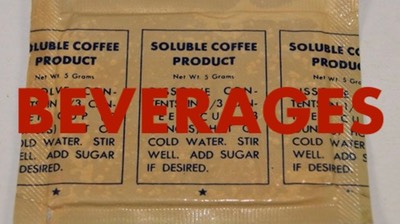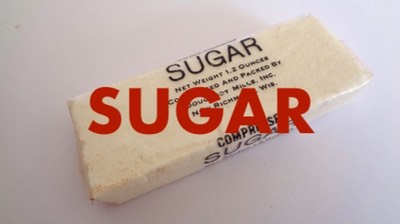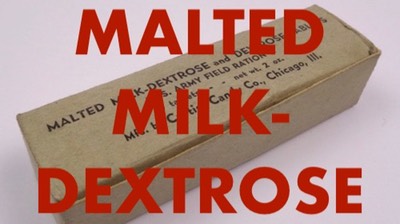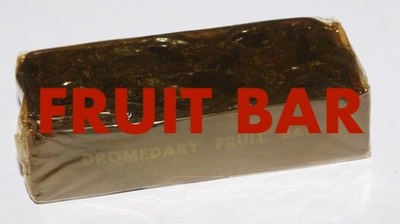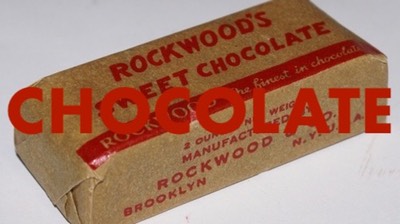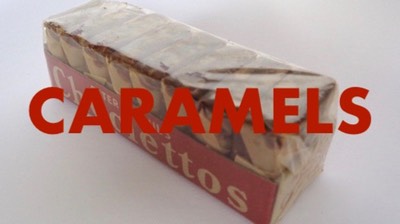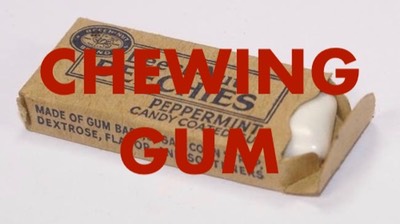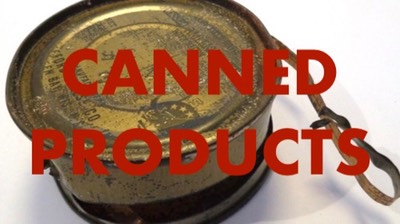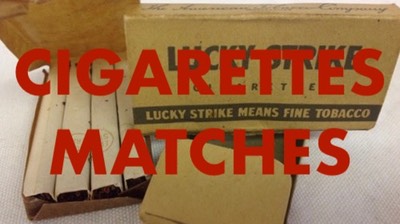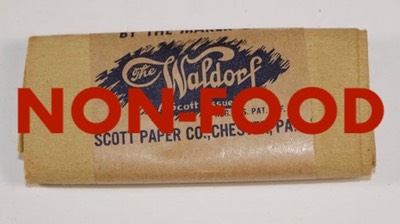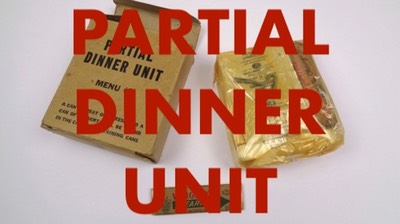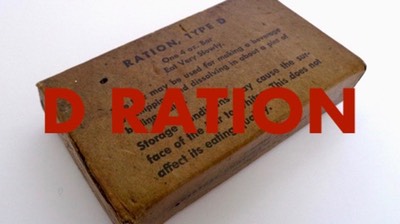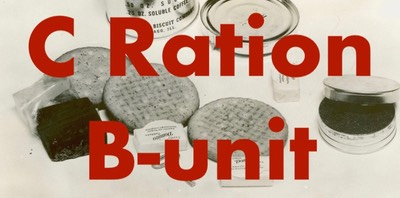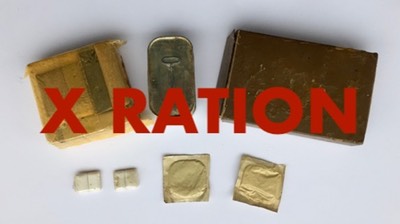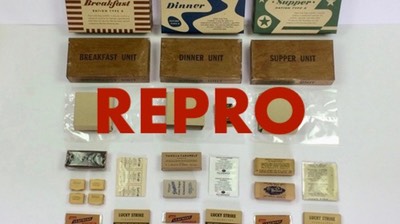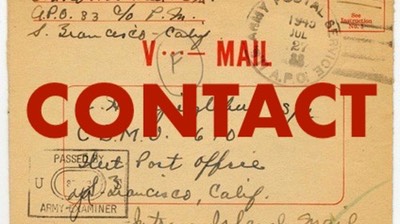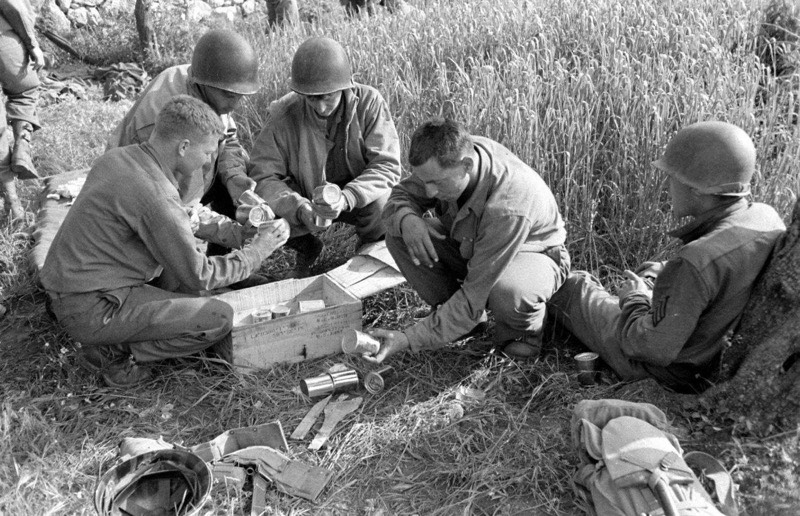
Increasing the variety of meat and vegetable component from three to six or seven varieties will materially complicate issues. We must not lose sight of the fact that this Type C Ration is only intended for use in emergencies in the forward areas of the combat zone, where it is impracticable to use cooking facilities or even heating facilities. The use of this ration will, therefor, be very infrequent and consequently a large variety is not essential.
Letter from Subsisance Branch to Supply Division OQMG. May 28, 1940
In the late thirties a proposal came up for a new emergency ration consisting of 8 ounces of bean-cereal, 1 ounce of soluble coffee and a 3-ounce chocolate-jam bar, all packed in a 12-ounce rectangular can providing one meal of said 1400 calories (a total of 4200 calories per ration). Three cans constituting a complete ration.
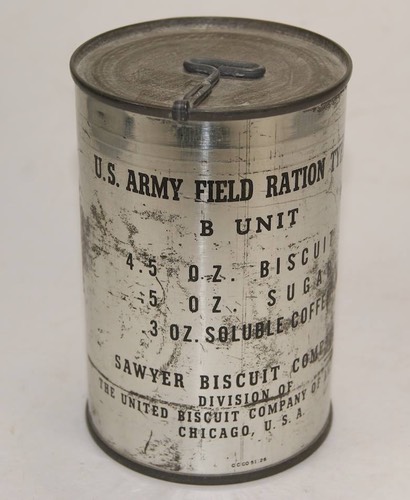
The total calorific contents was grossly overrated and actually contained 2000 calories. It was decided that an emergency ration therefore should at least consist of six 12-ounce (rectangular) cans constituting of 3 cans of the No. 1 Unit –a meat and vegetable product– and 3 cans of the No. 2 Unit –the bread component.
Due to low availability of the rectangular 12-ounce cans, 15-ounce cylindrical cans (size 300 x 407) were substituted.
The No. 1 and No. 2 units were also referred to as the A and B units.
This soon changed to the more logical M-unit (meat) and B-unit (bread). This will be used throughout the text.
In 1939 the ration was accepted as the new emergency ration consisting of three 15-ounce (cylindrical) cans containing three varieties of the M-unit: M-1 (Meat & Beans), M-2 (Meat & Vegetable Hash) and M-3 (Meat & Vegetable Stew) together with three identical 15-ounce cans of the B-unit. The Bread unit contained 4.5 ounces of biscuits, 0.5 ounce of sugar and 0.3 ounce of pure soluble coffee. One meal consisted of one of the M-unit varieties and one B-unit.
In 1939 the ration was standardized, in lieu of the A and B field rations, as the "U.S. Army Field Ration C”.*
*I do want to point out that the nomenclature “C” is the follow-up letter after the “A” and “B” type Field Rations and does not stand for “Canned” or “Combat” ration. The post-war canned ration, evolved out of the ww2 C Ration, is the “Ration, Combat, Individual”, but are commonly called C ration as well.
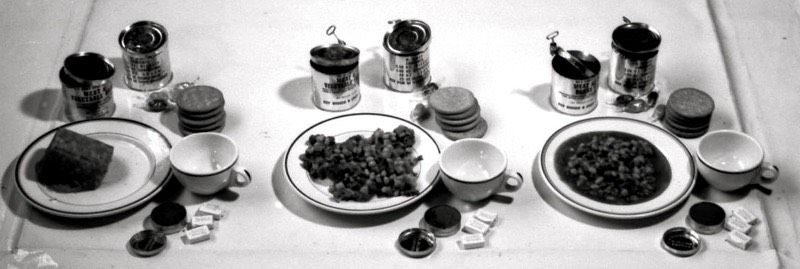
The C Ration in 12-ounce cylindrical cans exhibited here as three meals.
From left to right: Meat & Vegetable Hash, Meat & Vegetable Stew and Meat & Beans. All the B-units are identical.
During early field tests it was found that the ration contained too much food and in 1940 the size of the cans were reduced to 12-ounce (cylindrical) cans.
From now on all cans are of the cylindrical type, size 300 x 308. This means that the internal dimensions of the cans are 3 inches in diameter and 3 8/16 inch high.
With the reduction of the size a confection was added to the B-unit to bring up the calories. As of 1941 the B-unit contained 2.5 ounce of biscuits (5 each), 0.5 ounce of sugar (3 individually wrapped cubes), 0.25 ounce soluble coffee (packed in a small can, sealed with tape) and 1 ounce of a chocolate fudge.
The Meat units stayed the same although reduced in amount from 15 to 12 ounces. The total weight for one ration (six cans) is 4 pounds and 8 ounces.
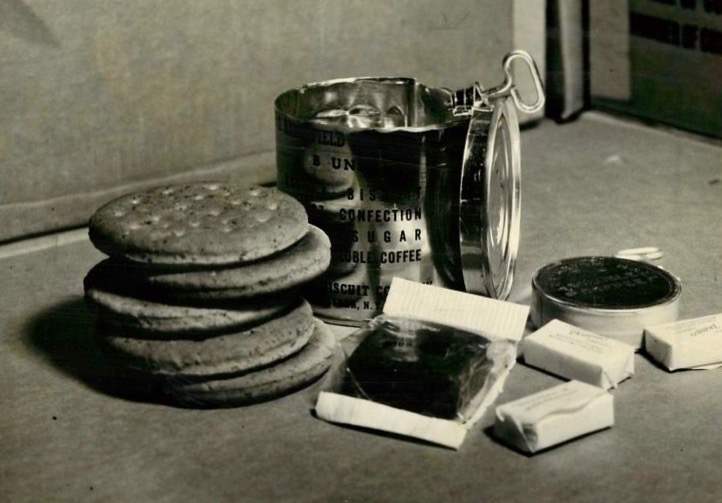
An early 12-ounce B-unit opened and showing its contents: five biscuits, tin pure soluble coffee, 3 sugar tablets, a piece of chocolate fudge and a seperate key for the M-unit..
The Bread Unit
Biscuits
Originally there were three types of biscuits considered for the C ration, providing a different type for each meal. For the ease of production and procurement only one type was accepted. This biscuit, however, was received enthusiastically during field tests and was also produced in a rectangular shape to be used in other rations and referred to as "Biscuit, Type C, square”.
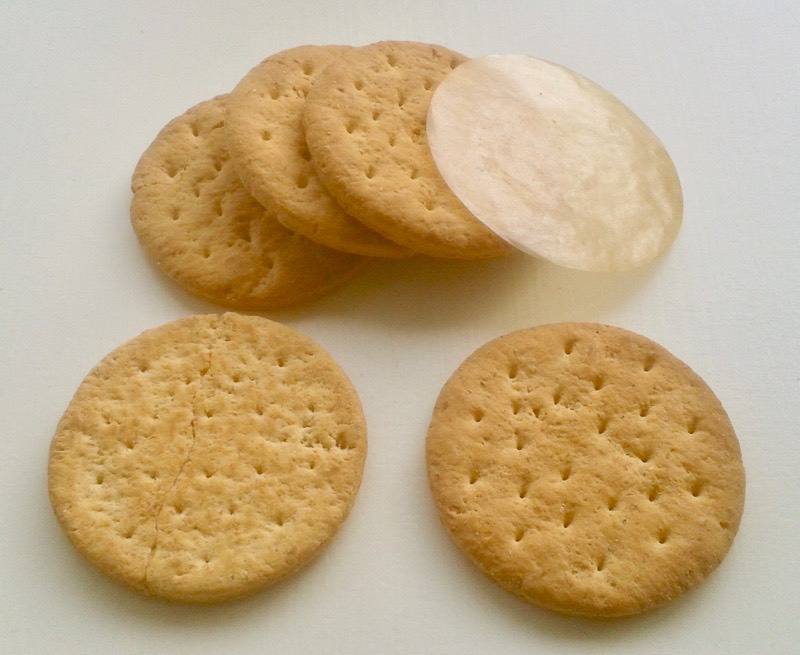
Five biscuits were included in the B-unit. Note the glassine disc to seperate the biscuits from the sugar tablets.
Reports from the battlefields were less positive and in late 1943 new varieties of the biscuits were developed. In June 1944 three varieties were accepted for the C Ration: A bread biscuit (an improved Type C biscuit), a neutral biscuit made with white flour only and a soda cracker (the same type as the saltines used in the K Ration).
Only one type was packed in a can, but each of the three cans contained a different type.
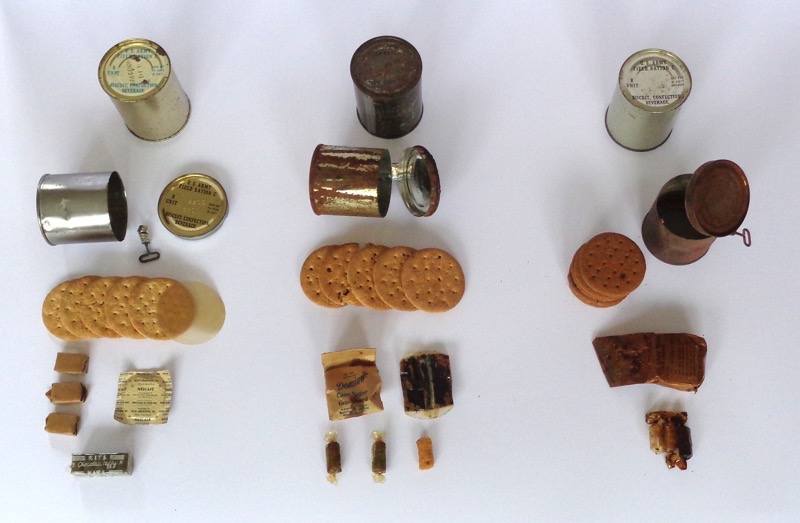
Here are the three mid war variations of the B-unit distinguished by its beverage: Coffee, Lemon and Cocoa. Only the B-unit containing coffee is dated (10-43) and appears to have the original type “C” biscuit. The other two units are undated and appear to have different types of biscuits.
Around the same time a disc of compressed mixed cereals was developed and replaced one biscuit in the breakfast B-unit. This could be eaten dry or crumbled into hot or cold water to make a gruel (porridge).
Early 1943 it was suggested to add a cookie in the ration, substituting a biscuit. The biscuits were considered to be eaten with the Meat component, so the cookie could be eaten with the coffee, providing a kind of dessert. Since the keeping qualities of cookies packed with other components were unknown and the fear that it might alter the taste of the biscuit or go rancid altogether, the idea was dropped.
In the summer of 1944, however, a new developed butterscotch cookie was included in the dinner unit, replacing a biscuit.
To make the biscuits more palatable a small tin with 1.5 ounce of fruit jam was include in the supper unit, replacing a biscuit. The jam was packed in a drawn metal can closed with a metal lid that was secured with a aluminum wrap-around strip. This was also included in the summer of 1944.
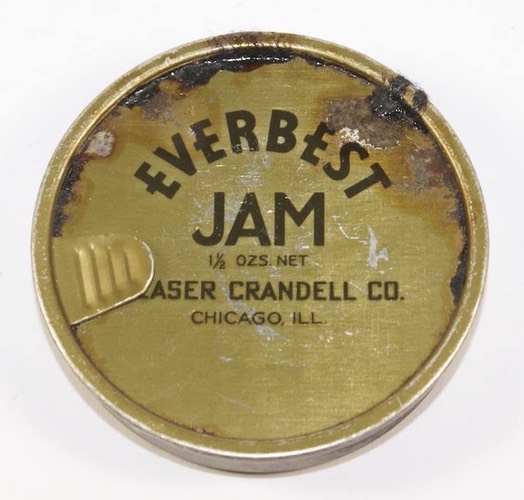
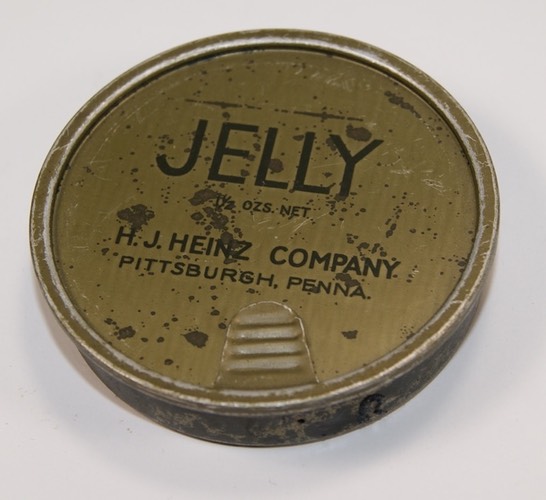
These new changes (the inclusion of different types of biscuits, cereal, cookie, jam and new confections) are introduced with the June 28, 1944 specifications.
With the reduction in the size of the cans the number of biscuits went from 9 to 6 biscuits and with the inclusion of a confection there was only room for 5 biscuits left. And finally one biscuit was replaced with a cereal disc in the Breakfast unit, a cookie in the Dinner unit and a can of fruit jam in the Supper unit. So, in the final version of the C ration there were only four biscuits left in the bread unit.
Beverage
To wash it all down, originally pure soluble coffee was included. In the original ration all three B-units were the same. Each contained a small aluminum foil envelope of pure soluble coffee. This coffee could be dissolved in either hot or cold water. The 15-ounce cans contained 0.3 ounce coffee, but his proved to make a too strong brew. After tests it was decided that 0.24 ounce was enough for one pint of strong coffee. For the sake of easy computing it was decided to reduce the amount from 0.3 to 0.25 ounce.
We will see that the amount of soluble coffee kept being reduced and went from 0.3 ounce to approx. 0.175 ounce (5 grams).
With the experimental B-units the pure soluble coffee was packed in aluminum foil envelopes. Due to the restrictions in the use of aluminum an alternative packaging for the coffee was needed. With the C Ration in full production the coffee was now packed in a tin container with a slip type cover that was sealed with a strip of adhesive tape. Adhering the tape was done by hand.
The tape did not sealed the tins properly and often moister crept in and turned the powdered soluble coffee into a solid block that would not dissolve in water properly.
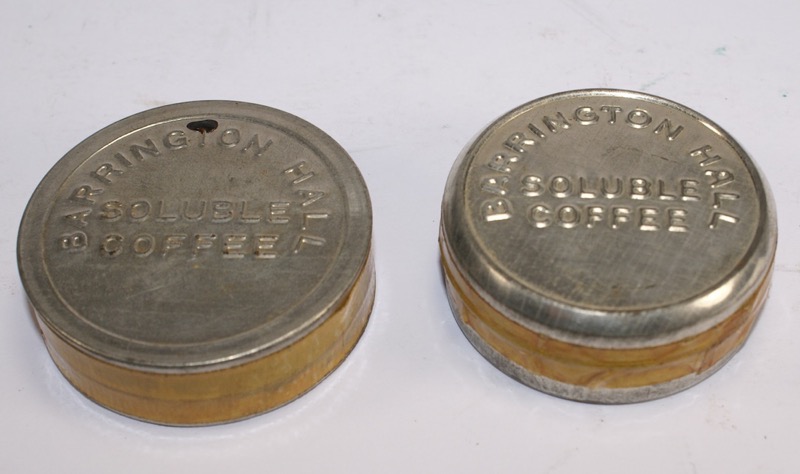
Two different slip-cover type tins used for Barrington Hall soluble coffee. Note how irregularly the tape is adhered to the tin on the right.
In december 1941 a new container for the soluble coffee was introduced. This was a shallow cup shaped tin that was closed with a plug type cover and the seam sealed with wax. The closing and sealing of the container now could be done by machines, speeding up the production.
The amount of soluble coffee was reduced again and 0.2 ounce was packaged in the plug type container.
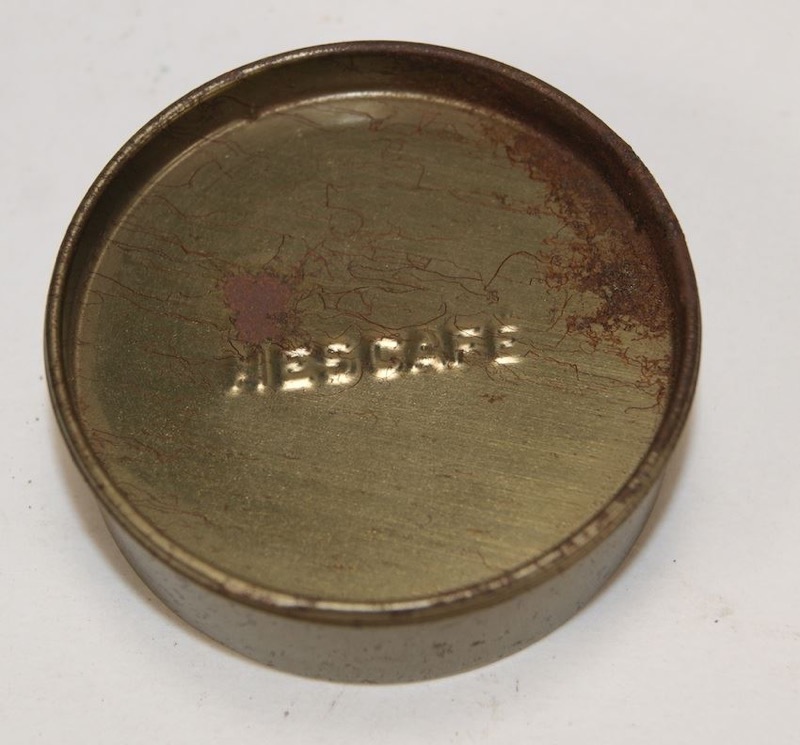
The original specifications called for pure soluble coffee, but in 1940 the Nestlé Milk Company marketed a new product under the name of Nescafé. This was a soluble coffee with maltose, dextrine and dextrose added for a milder flavor. Since this coffee product proved to be far more popular than the pure soluble coffee the specifications ware altered to "pure soluble coffee and/or soluble coffee product ".
Early 1942 the use of tin containers for the coffee was discontinued and the soluble coffee was now packed in an envelope of cellophane laminated to aluminum foil. These envelopes contained 5 grams of soluble coffee product, which is slightly less than the 0.2 ounce used previously, thereby reducing the amount again. This type of packaging for soluble coffee was first successfully used with the K Ration.
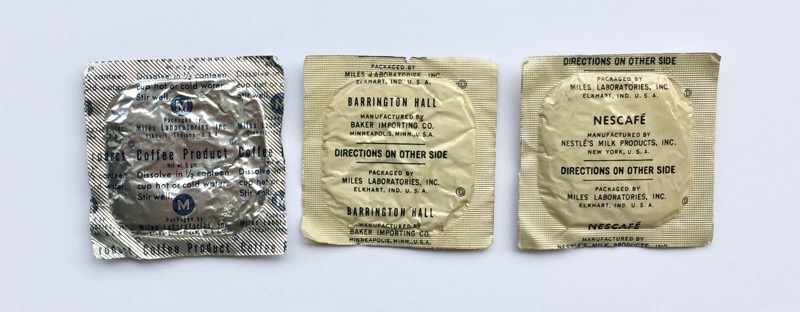
The square envelopes were the first type used with the C Ration because it would sit easier in the round cans during filling. Later the rectangular envelopes that were already in use with the K Ration were also used with the C ration.
In 1942 soluble tea was considered as an alternative to coffee to present some variety, but could not be obtained at that time and the idea was dropped.
During a field test of the ration in early 1942, a soluble cocoa beverage was substituting the coffee in one of the B-units. This was received positively by the troops testing the ration. Also, the synthetic lemon juice powder that was used in the new K Ration was well received in this test. Probably because it makes a better drink with cold water.
It was suggested that in one of two B-units the coffee was replaced with an envelope containing 7 grams of synthetic lemon juice powder and a 2.5-ounce package of cocoa beverage respectively.
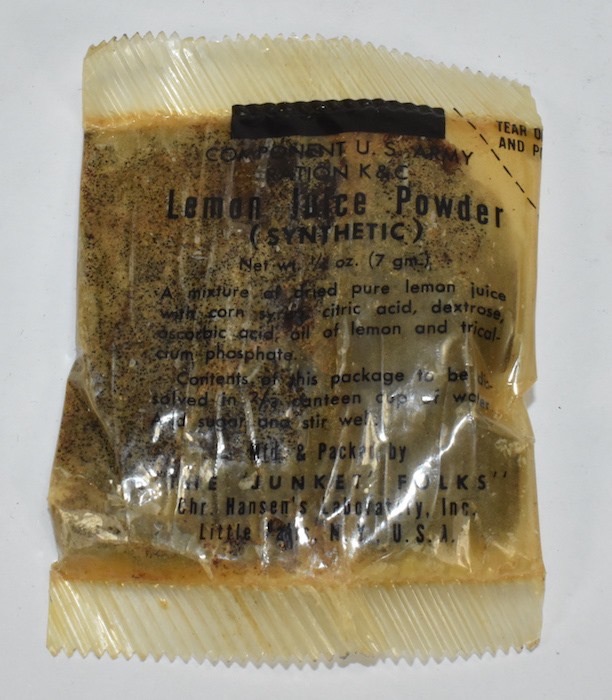
A cellophane envelope with Lemon Juice Powder. Over to time the white crystals have darkened to brown. Later the rectangular aluminum foil envelopes were also used.
The lemon juice powder was packed in a cellophane envelope, but with the introduction of other flavours the rectangular cellophane and aluminum foil laminated envelopes, the same type as used in the K Rations, were more commenly used.
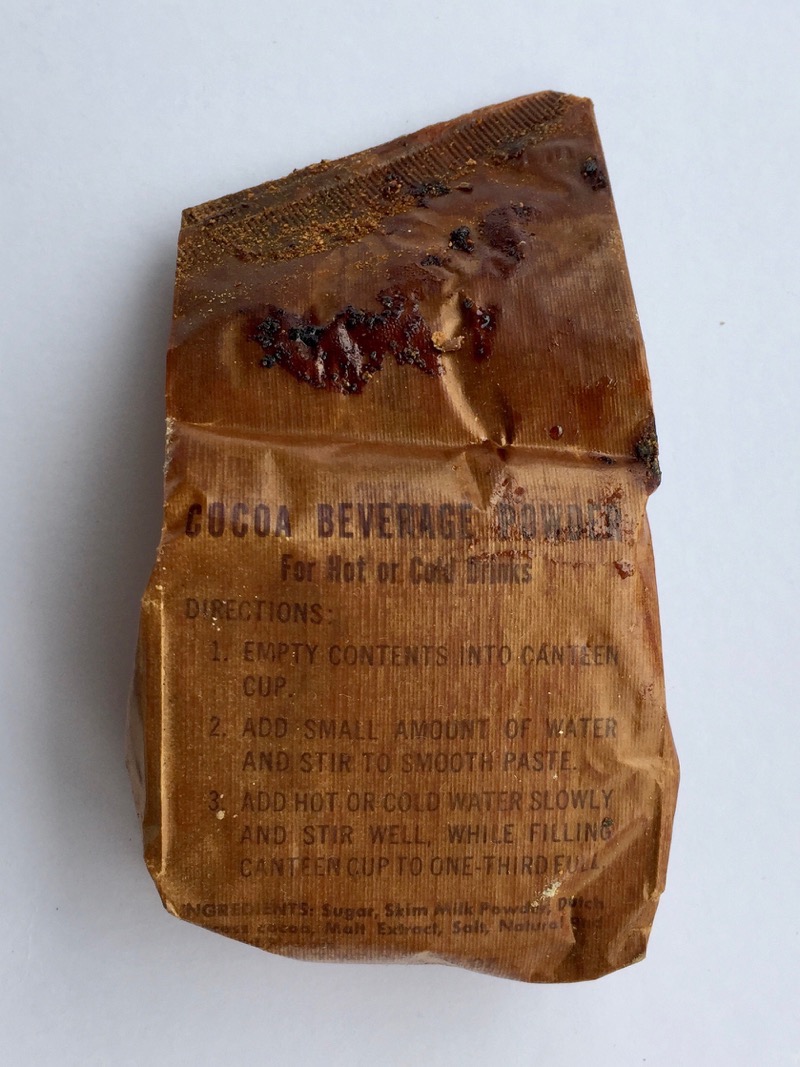
The Cocoa beverage powder was packaged in parchment paper bag (above) or in a cellophane bag (below). Instructions for preparation were printed on the bag.
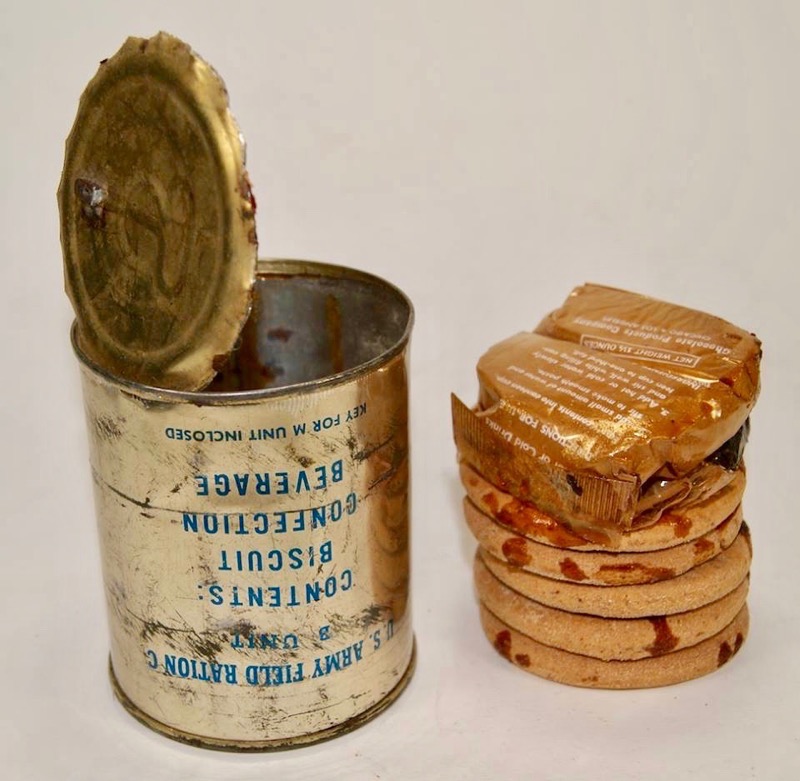
The cocoa beverage was packed in a laminated bag of parchment and glassine. Due to shortages of the parchment/glassine laminate, a cellophane bag was also allowed to be used. Later the cocoa came in a cellophane wrapped compressed disc.
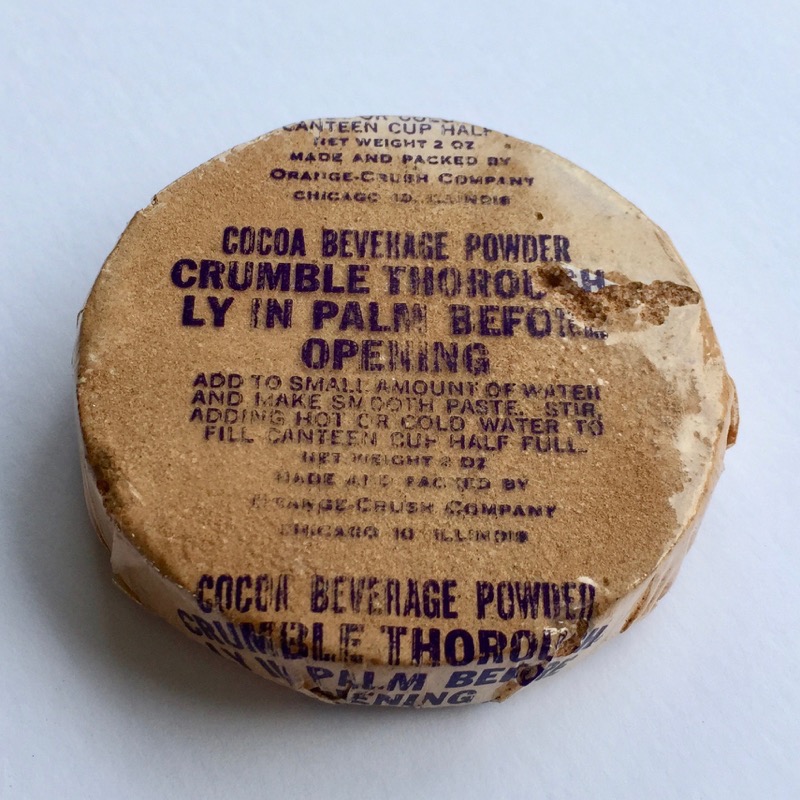
The label on the cellophane wrapper for the compressed cocoa powder instructs that the disc should be squeezed to a fine powder before opening the packaging.
The cans that were already procured and read "coffee" on the label would be embossed on the top end of the can with the letter "C" for coffee, "L" for lemonade and "CB" for cocoa beverage.
Newly procured cans would read "beverage" on the label and the words COFFE**, LEMON or COCOA embossed in full on the top end.
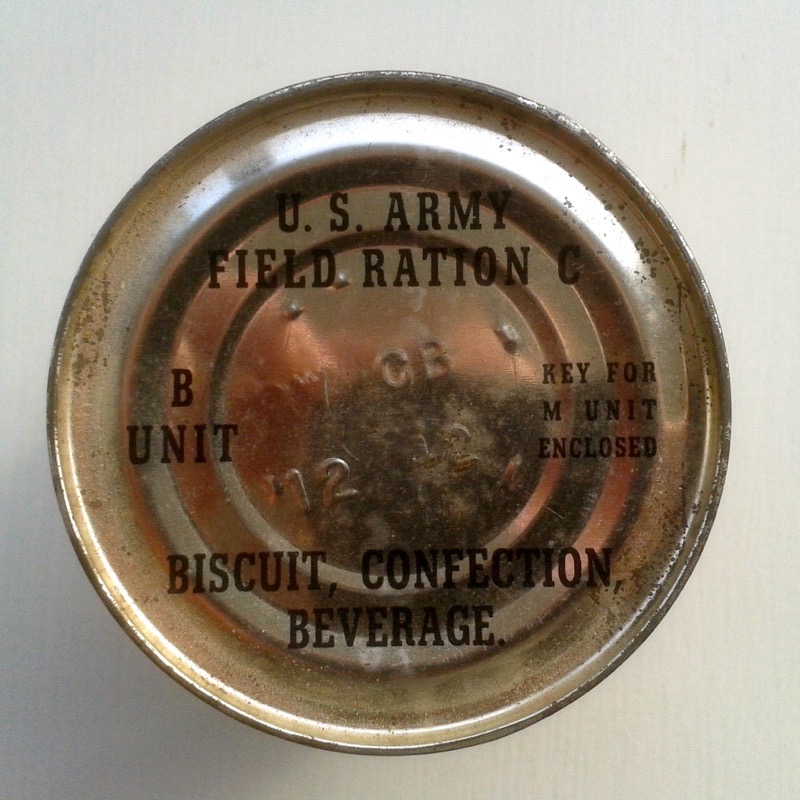
Note the “CB” embossing for Cocoa Beverage while the label already reads "beverage" on this December 1942 dated B-unit.
Later the Lemonade was alternated with a synthetic Orange juice powder and with the latest version of the C Ration the use of Lemon juice powder was dropped and Grape juice powder was substituted, alternating with the Orange juice powder. The embossing would read either LEMON, ORANG** or GRAPE.
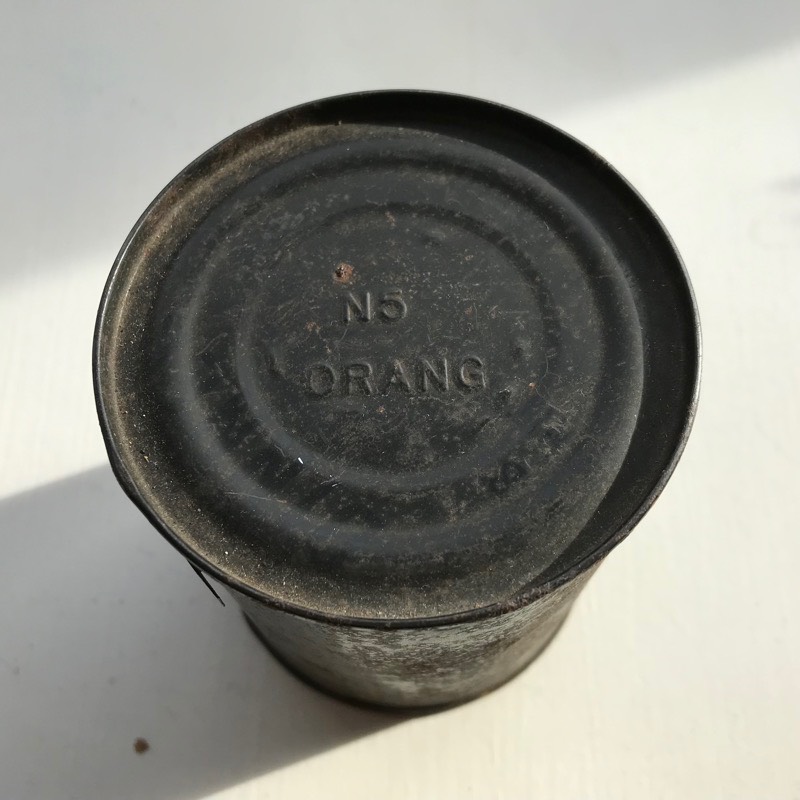
A late war production B-unit embossed with the word ORANG indicating that the beverage enclosed is the Orange juice powder.
The olive drab coating has darkened so much overtime that the label, printed in black, has become almost unreadable but the word DINNER can still being made out.
The bouillon powder that was developed for the K Ration was not used with the C ration.
**Most lid embossing machines were usually limited to two lines with five letters each. Also, the Army preferred that no more then two lines with five characters were used since it was feared that excessive embossing might damage the protective coating of the can. This explains the odd spelling.
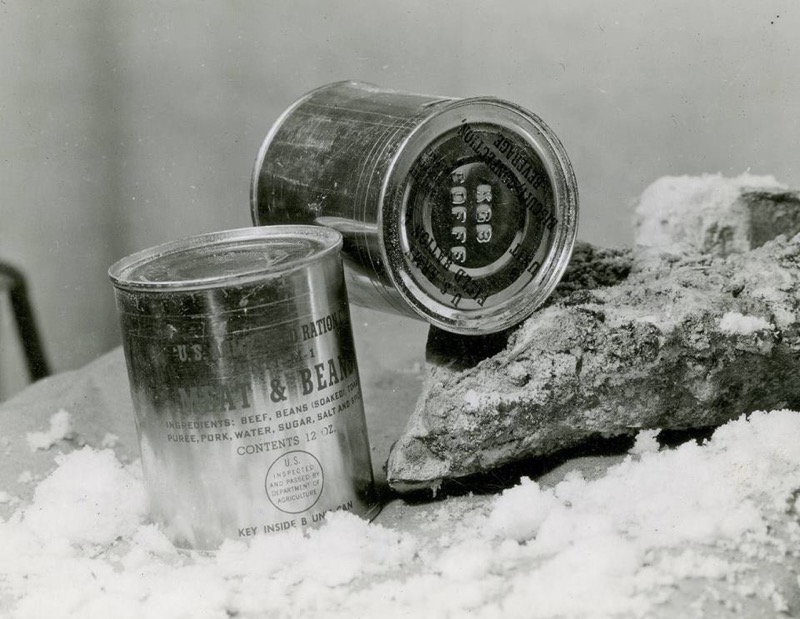
Note the COFFE embossing on the B-unit.
Sugar
To sweeten the coffee three individually wrapped sugar cubes were included. As with the K Ration the sugar was obtained from commercial sugar companies. Most of these companies used their commercial sugar packagings and carried fancy printing of their logos and slogans on the wrappings. Domino and Jack Frost seem prevalent. Plain brown wrapping was also used.
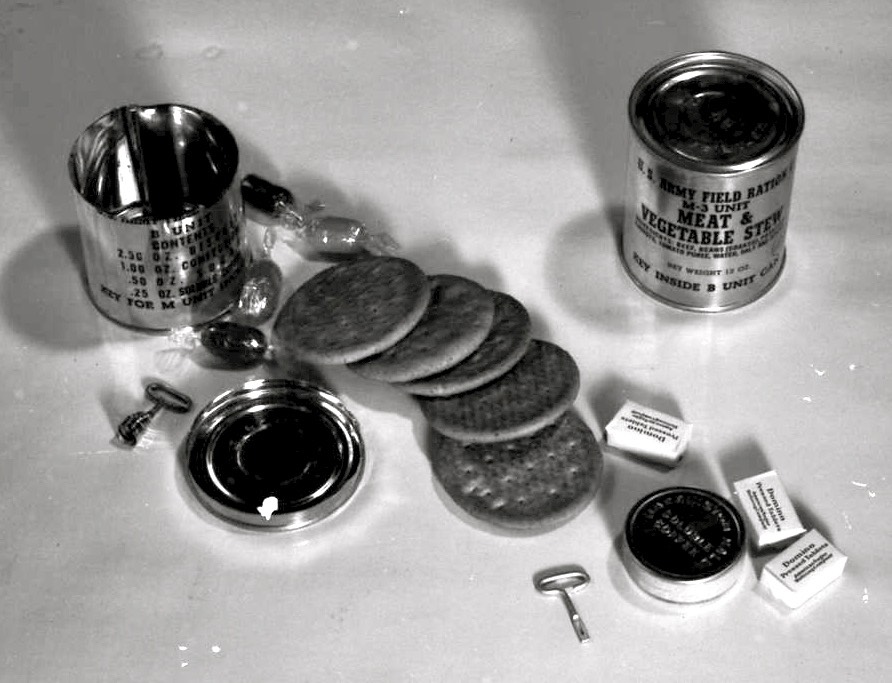
An early C Ration dinner that still uses the early white paper wrappers for the sugar tablets. Note the extra key for the M-unit.
The amount of sugar included increased greatly during the evolution of the C ration. Three sugar cubes were provided to sweeten the coffee. (Labelled as 0.5 oz. sugar on the can.) This was later increased to four cubes (0.8 ounce).
The lemon juice powder itself has an acid taste and requires a lot more sugar to make it acceptable. In its infinite wisdom the Army provided the soldier with twice as much sugar for the lemonade than for the coffee. Where the coffee needed only three cubes, the lemonade came with 6 cubes! An alternative to the six sugar tablets was a small package –either a carton or a bag– of 1.2 ounce of granulated sugar. Later a compressed disc of granulated sugar was developed weighing 1 2/3 ounce (1.66 oz.) for the juice powder. This disc was easier to pack into the cylindrical cans than the six tablets or a rectangular package.
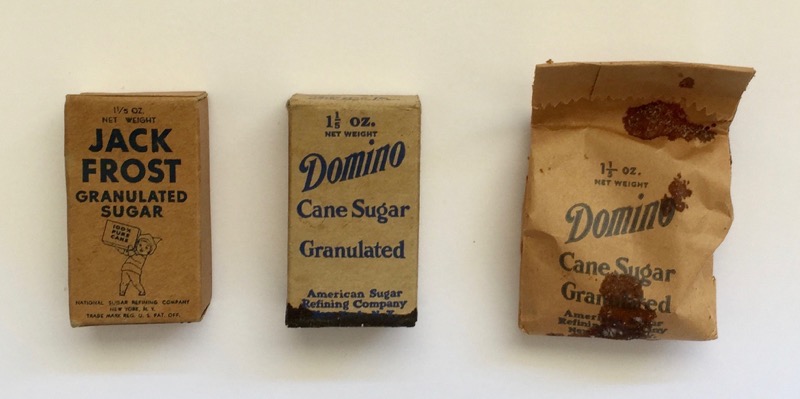
With the cocoa beverage no sugar was needed since the sugar was already pre-mixed with the cocoa and milk powder.
Confection
To increase the calorific contents of the size reduced rations, the inclusion of a 1- or 2-ounce chocolate (D-)bar was considered. This was, however, not deemed feasible because of taste transfer from the chocolate to the biscuits. Instead a new type of chocolate fudge was developed that could be included with the B-unit. The 1-ounce fudge was fortified with vitamins of the B complex. Complaints from field tests indicated that the fortified chocolate wasn't palatable after prolonged storage.
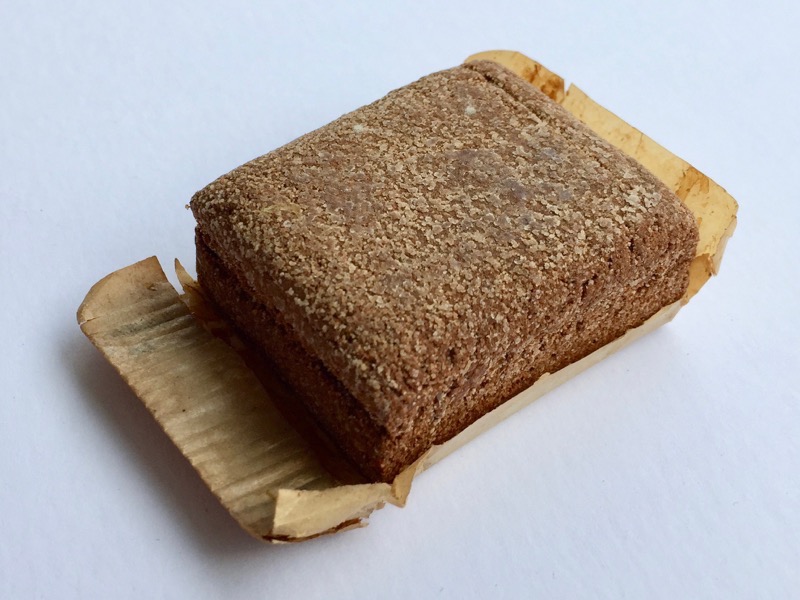
A tasy looking 75 year old chocolate fudge
An alternative was found in hard candies. The flavors finally chosen in August of 1941 were lime, lemon, orange and butterscotch. At first these candies were of the square type that were easier to machine wrap, but proved to be more difficult to (machine) dump them into the cans on the assembly line. Later round and cylindrical shaped candies were used.
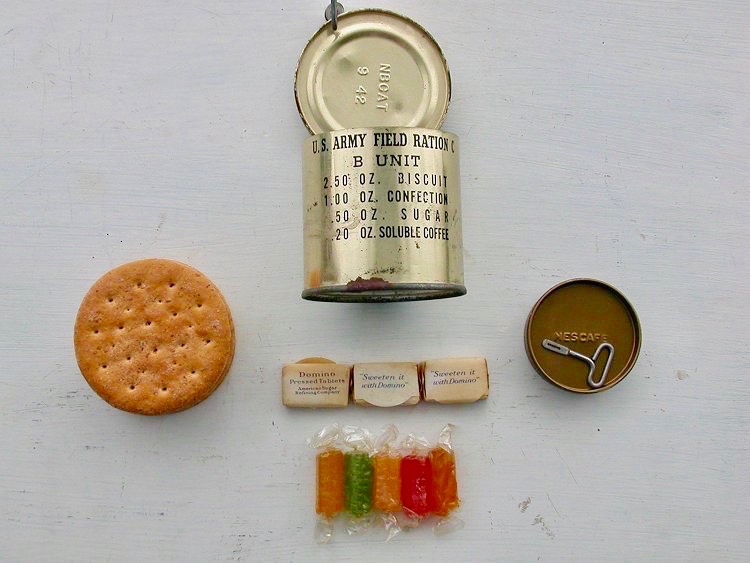
A B-unit, packed in September 1942, containing five cylindrical candies. Later the amount of candies was reduced to three pieces. Note the colors of the candies indicating different the flavours.
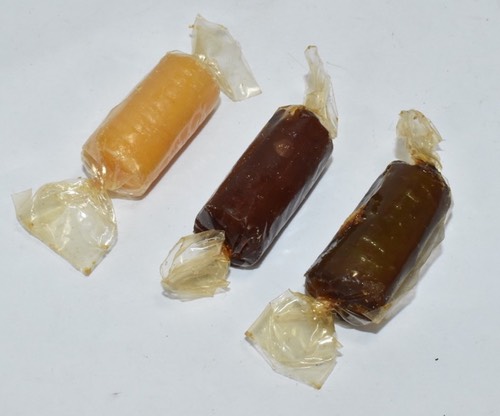
The reason for adding hard candies was based on the idea that the confections were consumed in between the meals, providing the soldier with extra energy throughout the day. The original amount of one ounce proved to be too much candy for the average soldier and the amount was reduced to 3/5 of an ounce.
A caramel candy was accepted in late 1941 as a substitute, but was three months later discontinued due to poor keeping qualities.
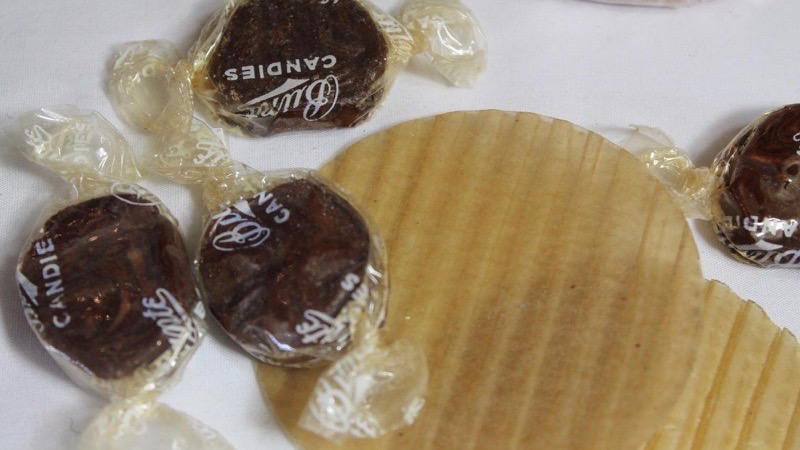
The short-lived caramel candy made by Bunte. Note the corrugated glassine discs.
In 1943 a new caramel candy was introduced and included with the C Ration. Some of these caramels were of the individualy wrapped square type, others were packed five together in one package, and these were included in the breakfast.
Around this time the fortification with vitamin C was being studied and ascorbic acid was added to some of the hard candies.
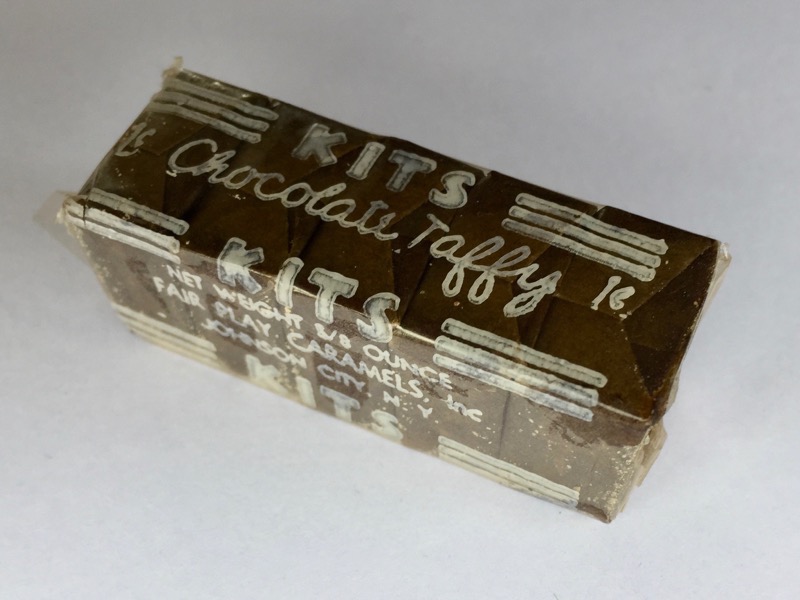
A small package of KITS Chocolate Taffy made by Fair Play Caramels, Inc.
In the summer of 1944 a small glassine or kraft envelope with 1.2 ounce of candy coated peanuts was added to the breakfast of the B-unit. The dinner B-unit held 5/8 or one ounce of caramels. The supper B-unit still contained the hard candies, but are now fortified with vitamin C.

A late war C Ration showing the contents of the B-1 menu #1: four biscuits, compressed cereal disc, soluble coffee with four sugar tablets and candy coated peanuts.
The M-unit is the M-1 Ham & Eggs with Potatoes.
Still new varieties were developed and as of 1945 there was also a vanilla and a chocolate fudge disc, and a package of chocolate drops added. Making a total of six different types of confections.
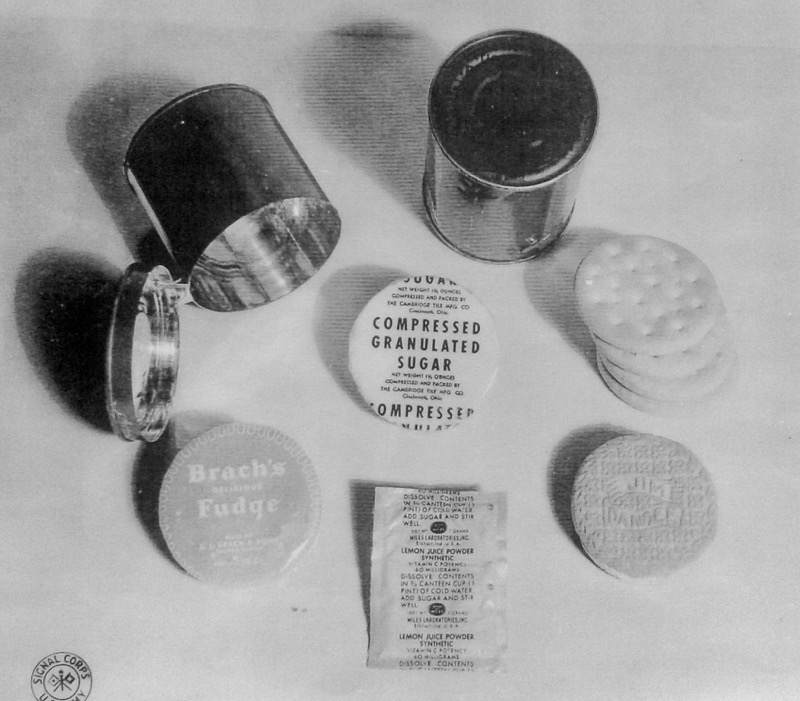
The B-2 menu #1 components are: four biscuits, vanilla (or chocolate) flavoured fudge disc, butterscotch cookie, and lemon juice powder with compressed sugar disc.
The M-unit is the M-5 Meat & Beans.
It must be noted that the quantity is not always correct, some times the filling was done by hand and by mistake more or less candy could be included, or if done automatically, a filling machine would dump an average of a certain quantity. The same goes for the number of sugar tablets, or even an extra coffee envelope could be inserted by mistake!
Also, changes due to new specifications were incorporated during production, sometimes even in the middle of a production run. Old stock cans with the lithographed label on the body could be used with the new components. While some companies were using the new camouflaged cans, others were still using the gold lacquered ones until that old stock was used up too. So dates and contents of the cans may not correspond with the acceptance date of the changes.
Non food items in the B-unit
It was found that moister from the biscuits transferred to the sugar when they were in contact of each other, thereby discoloring the sugar.
To prevent contact, a glassine disc was placed on top of the biscuits in the units containing the coffee and lemonade. If the carton of granulated sugar was used instead of the sugar cubes the envelope containing the lemon juice powder was to be placed between the biscuits and the package of sugar.
Since the B-unit with the cocoa beverage contained no sugar a glassine disc was not needed.
Later specifications called for a glassine disk to be also placed between the bottom of the can and the biscuits. This was done to prevent rusting of the can where the spotwelding burned through the tin coating when attaching the key to the bottom of the can.
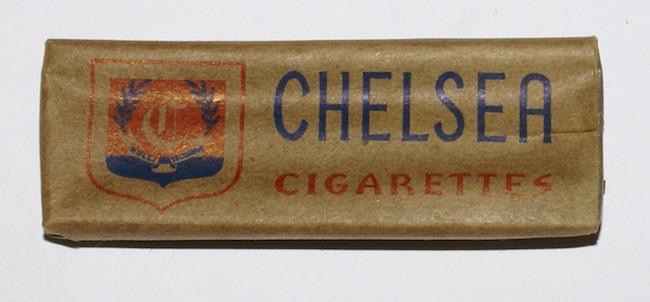
A soft package of three Chelsea cigarettes. (The clear cellophane wrapping is missing.)
The inclusion of cigarettes were considered and in March 1943 a small package of 3 cigarettes –either a small carton or a “soft" package– were included in the B-units containing coffee and lemonade. Since the cocoa beverage packaging was quite bulky, there was simply no room to insert a package of cigarettes. The inclusion of cigarettes in the ration was soon discontinued, probably because the cigarettes impaired the taste of the food, or the other way round.
Early 1941 an extra key for opening the M-unit was included with the B-unit, but was discontinued late 1942. More on this in the Packaging section.
The Meat Unit
As mentioned above, the earliest ration consisted of three meat varieties. Initially it was suggested that there should be ten varieties, but since the ration was considered an emergency ration, three would be sufficient. It was felt that the ration would not be used over a prolonged time, but merely for one day or even just one meal. As with the K Ration, this turned out not to be the case…
M-1 unit
Originally referred to as Pork and Beans, the meat consisted of pork and beef due to shortages of pork. When the ration was standardized it was named Meat & Beans. The formula for the Meat & Beans was 25% beef, 25% pork, 20% beans and 30% tomato sauce or juice. A little flavouring was added. In 1942 the beef was increased to 40% and the pork reduced to 10%.
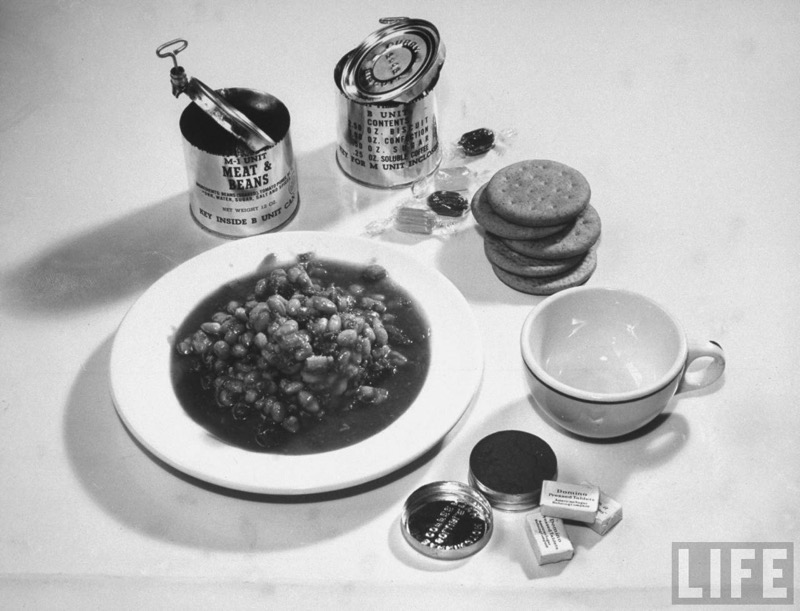
When openening the can with the key, the thin tomato juice would spill easily and soil hands or clothing. This was later remedied by includng a small can opener.
M-2 unit
The Meat & Vegetable Hash turned out to be the least popular variety, sometimes referred to as dog food!
The formula that made it so unpopular was: 40% beef, 10% pork, 48% potatoes and 2% unions with salt, celery salt and pepper added.
In 1941 the use of dehydrated potatoes was authorized to speed up production and in 1942 in lieu of fresh unions the use of powdered dehydrated unions was also permitted.
The use of dehydrated potato and unions made it actually a gooey block with chunks of meat embedded in it.

Although the diced potato is still visible in this early production, the potato starches already caused the Hash to form a firm block.
M-3 unit
Meat & Vegetable Stew was the third M-unit and the initial specifications only called for beef, but it turned out that the beef didn't contained enough fat to prevent sticking during the cooking process and a 10% pork was substituted for beef early 1943.
Now all the meat units contained beef and pork in the same proportions. The formula for the stew is 40% beef and 10% pork (instead of 50% beef), 15 % potatoes, 15% carrots, 8% beans and 12% tomato product with the addition of the same seasoning as the hash. Again dehydrated potatoes were permitted.
In 1940 there was a concern about the amount of beans used in the C Ration, so for a short while peas were used in the M-3 unit instead of beans.
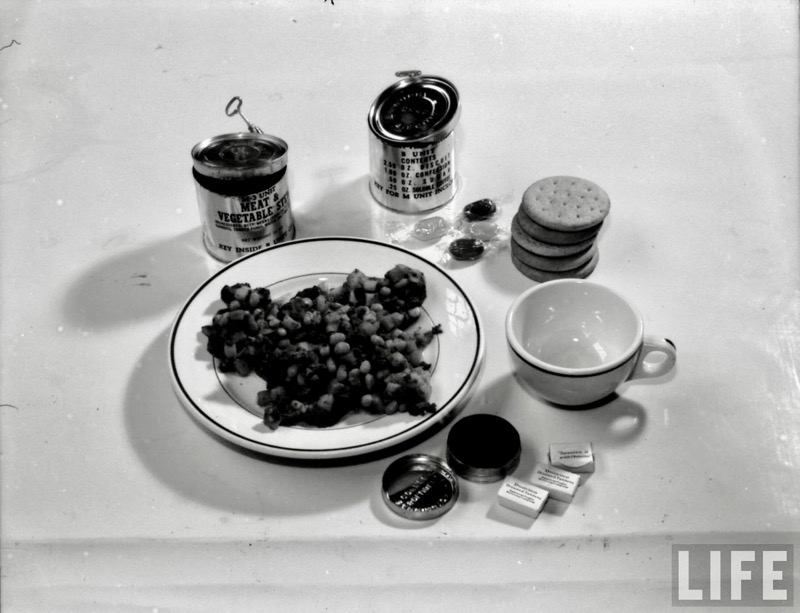
Due to the beans in the Stew this M-unit is usually remebered as just another Meat & Beans by many veterans.
More varieties
Although the search for more varieties continued, these three meat dishes were used throughout the war. In 1943 several fish products were tested. Because not everybody likes fish, the fish taste would be as little as possible. However, a satisfactory fish product that was acceptable to everyone could not be developed and the idea of a fish variety was dropped.
The search continued and at the end of 1943 two more meat dishes were added: Ground Meat with Spaghetti, and English Style Stew. The latter was a new variety that was also included in the new 10-in-1 Ration. In The spring of 1944 there were four more varieties added: (1) Meat & Rice, (2) Ham, Eggs & Potatoes, (3) Beef & Noodles, and (4) Frankfurters & Beans.
As of June 1944 eleven varieties were listed: M-1 Meat & Beans, M-2 Meat & Vegetable Hash (new recepy), M-3 Meat & Vegetable Stew, M-4 Ground Meat & Spaghetti, M-5 Ham, Eggs & Potatoes, M-6 Meat & Noodles, M-7 Pork & Rice, M-8 Frankfurters & Beans, M-9 Pork & Beans, M-10 Ham & Lima Beans, M-11 Chicken & Vegetables.
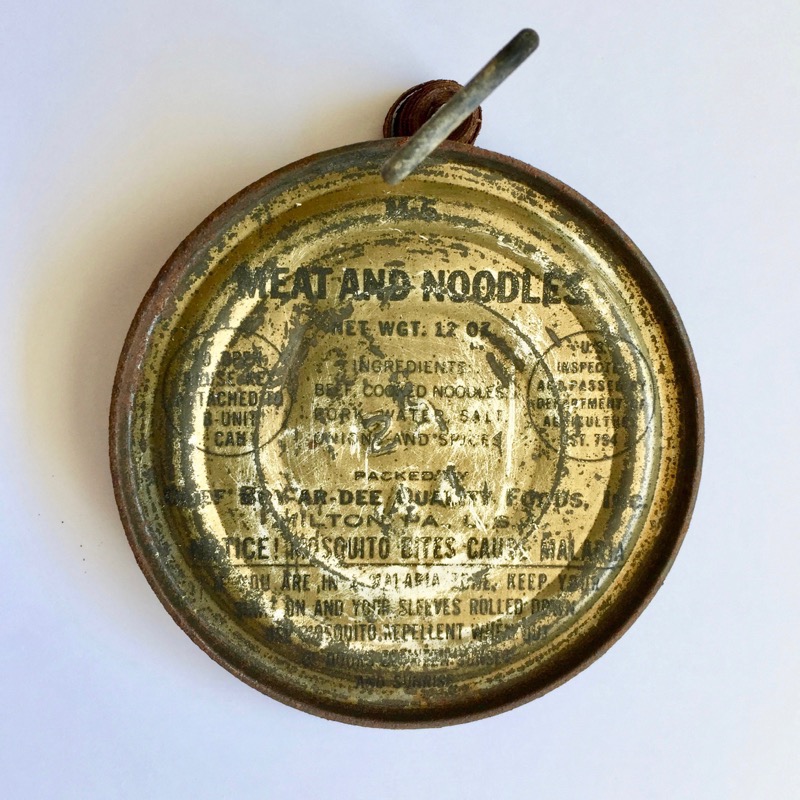
This camouflage lacquered lid of Meat & Noodles, packed by Boy-Ar-Dee, carries the warning against malaria introduced later in the war.
Apparently the English Style Stew was dropped by the end of 1944 (as was also the case with the 10-in-1 Ration) and in 1945 the ever unpopular Meat & Vegetable Hash was finally dropped too. There were now ten M-unit varieties as was originally suggested in 1939.
Accessory kit
Besides the short lived inclusion of the cigarettes the C Ration only contained food. One of the advantages of the K ration were the inclusion of non-food items such as the cigarettes, toilet paper and matches.
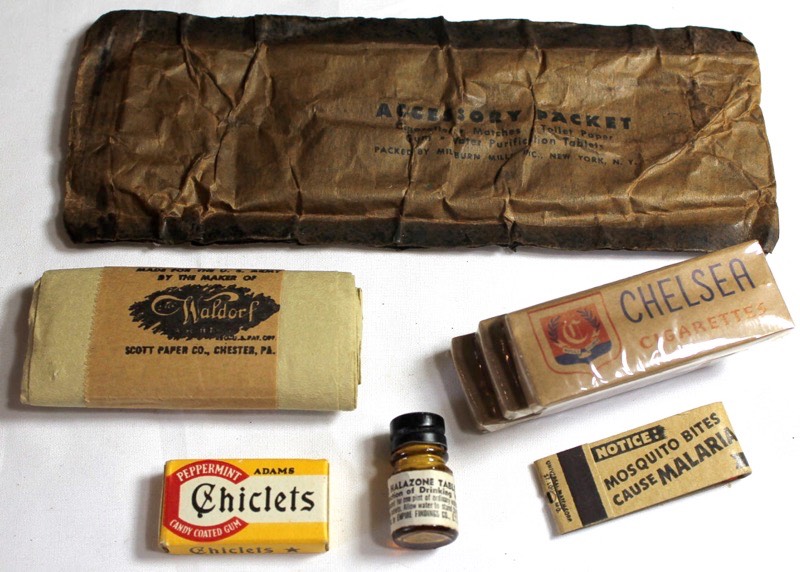
The first version of the Accessory Packet containd Halazone tablets and three separate cigarette packages.
An accessory kit that could be issued with the ration was suggested early 1944. By the summer of 1944 a sealed asphalt paper laminated to a metallic foil envelope was developed that contained a small package of 12 sheets of toilet paper –the same as used in the K Ration–, a package with two tablets of sugar coated chewing gum, a small bottle with 12 water purification tablets (Halazone), and a small matchbook with two rows of five matches each.
The small bottle with Halazone tablets was soon replaced with a small plastic vial holding 4 salt tablets.
Interestingly, the specifications of 31 October 1944 includes both water purification tablets and salt tablets as components of the accessory packet. However, the instructions for the label on the accessory packet only mentions the water purification tablets. Also, only the packaging of the water purification tablets are described in detail in the specifications. The sal tablets are not mentioned at all.
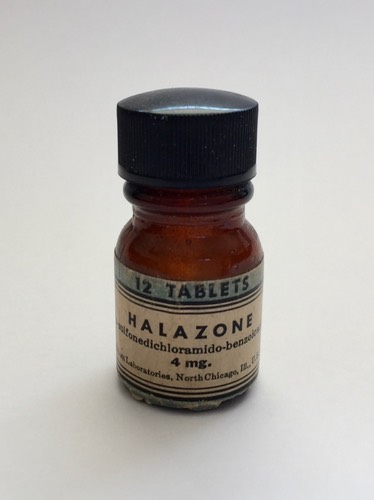

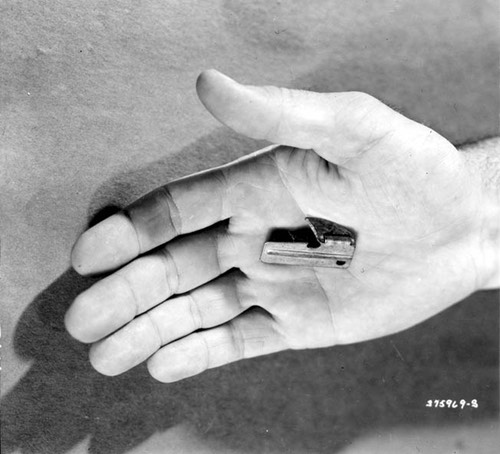
Eight of these accessory packages were inserted between the cans. One of these eight packages had a can opener added. Officially named "Opener, Can, Small, Individual", it is populary known as the P38 can opener. This can opener was inserted in a small brown envelop with instructions printed on it, the envelope than was packed inside the kit with the other components. The accessory kit containing the can opener was labeled "Can Opener Enclosed”.
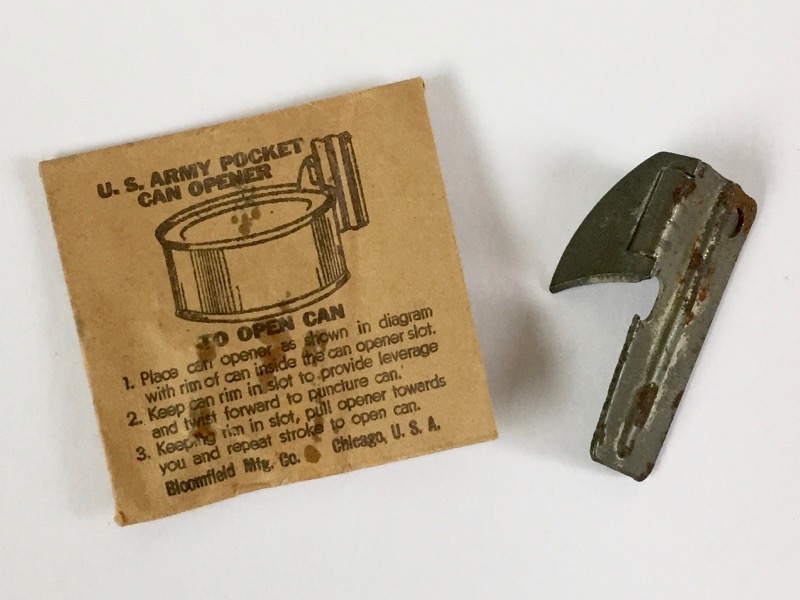
The can opener came in a kraft envelope with instructions printed on the front. The ww2 envelopes only have three lines of instructions while the post-war envelope has four lines.
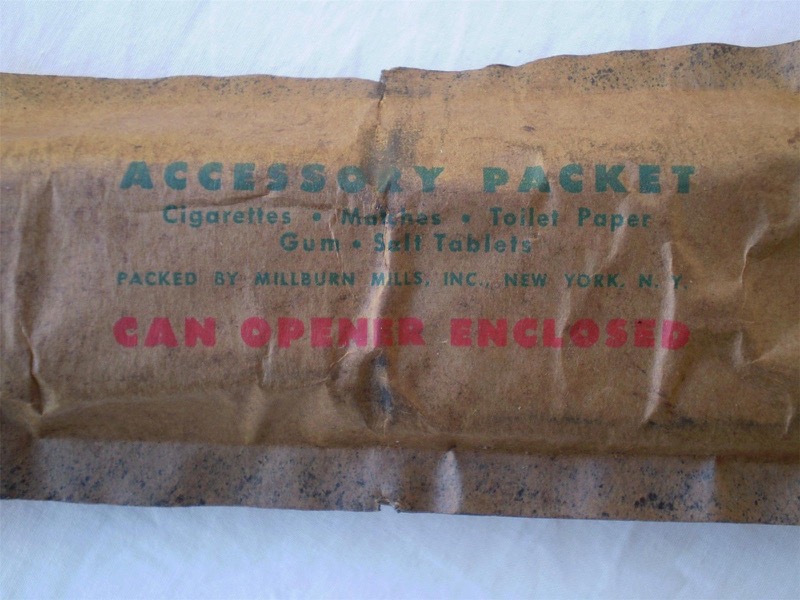
The text “can opener enclosed” is printed directly on the packet in red during production. Alternative methods were a piece of paper tape printed with the text “can opener” adhered to the packet or the text was hand stamped onto the packet.
In the spring of 1945 four salt tablets or an envelope of 1/2 ounce granulated salt and three wooden spoons were added in place of the Halazone tablets. The cigarettes and matches were packed in a separate package and inserted between the cans. The accessory kit now was referred to as the Accessory Packet (Long) and the Cigarette Packet (Short).
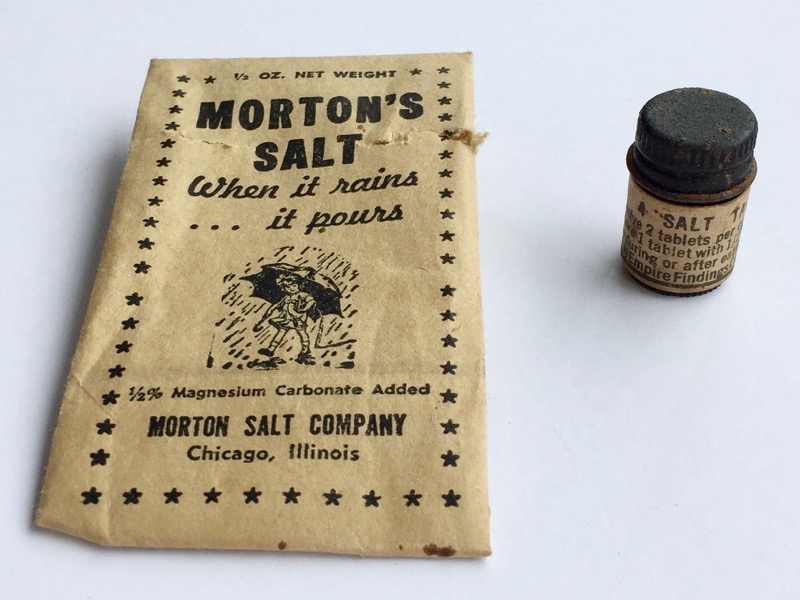
The cigarettes previously includedin 1943 in the B-units were added to this accessory kit. Two styles of packaging were used: three packages of three cigarettes each were packed together with cellophane. This was probably done with the still existing stock that were made for the earlier inclusion of three cigarettes in the B-unit. Alternatively, a carton holding nine cigarettes was used.
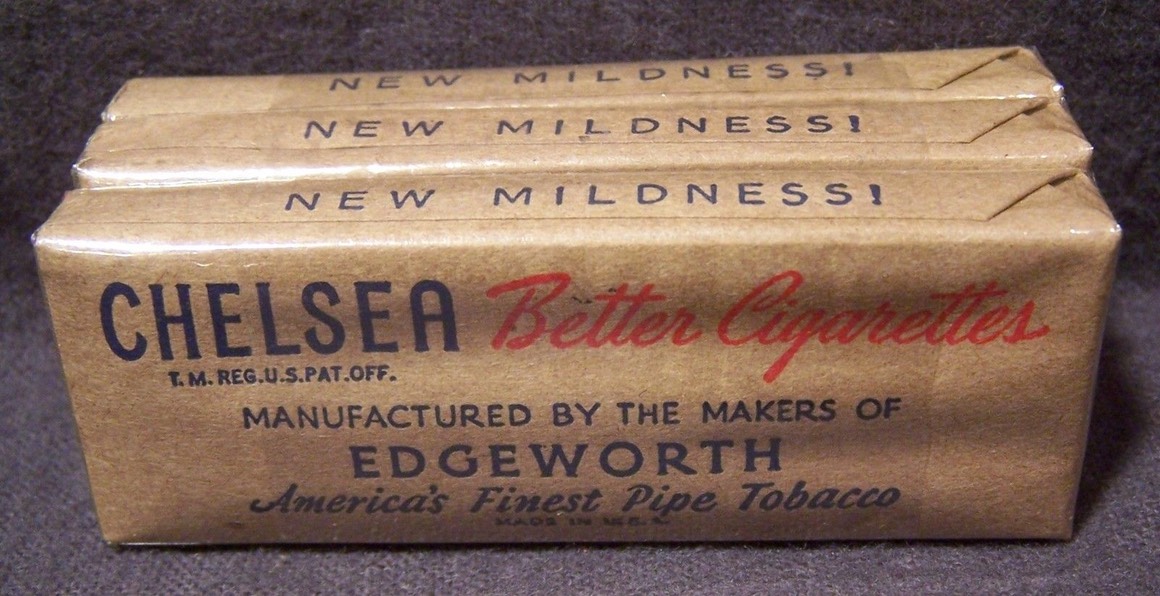
Above: three packages with three cigarettes each are packed together with a band of cellophane. Below: one package with nine cigarettes.
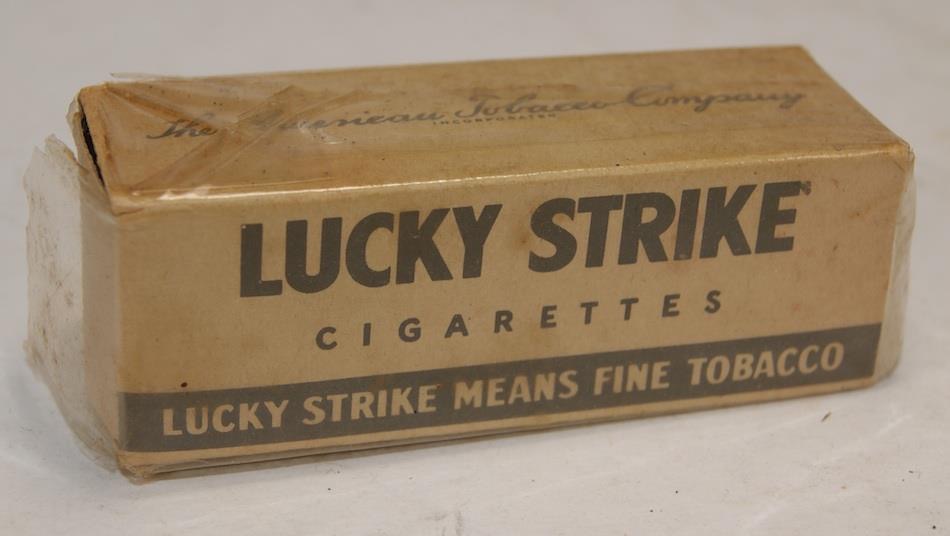
A small package with two sugar coated tablets of chewing gum was aslo included in the accessory packet. This could be the cellophane wrapped (Chiclets), paper wrapped (Wrigley’s PK’s) or a small cardboard box with two tablets in it (Beechies or Chiclets). Again, these are the same ones as found in the late K Rations.
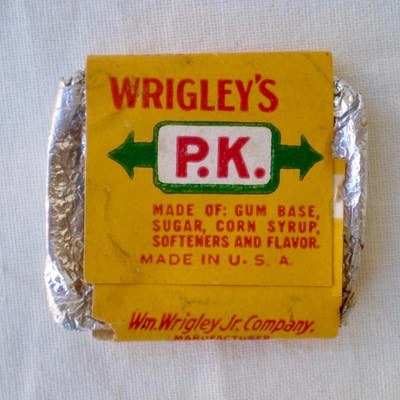
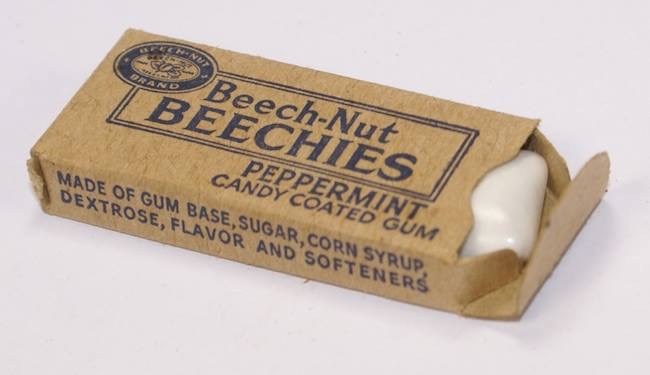
Packaging
The Cans
From the start the emergency ration was intended to be packed in tin cans. It was felt that this was the only means of packaging that was positively safe against gas contamination. One gas attack on a ration dump could render the thousands of collected rations useless. Even when tin became a critical material the C Ration was still to be packed in metal cans. This would also protect the ration agains insects, a serious menace in the tropical theaters.

Three GIs who are part of a 60mm mortar team are dining on very cold C Rations. Date and place are unknown but probably taken during the Battle of the Bulge.
As mentioned earlier, the original idea was to use 12-ounce rectangular cans. Since there was an insufficient manufacture of these style of cans, the decision was made to use the commercial cylindrical cans. The reduction in size from 15- to 12-ounce cans has also been mentioned.
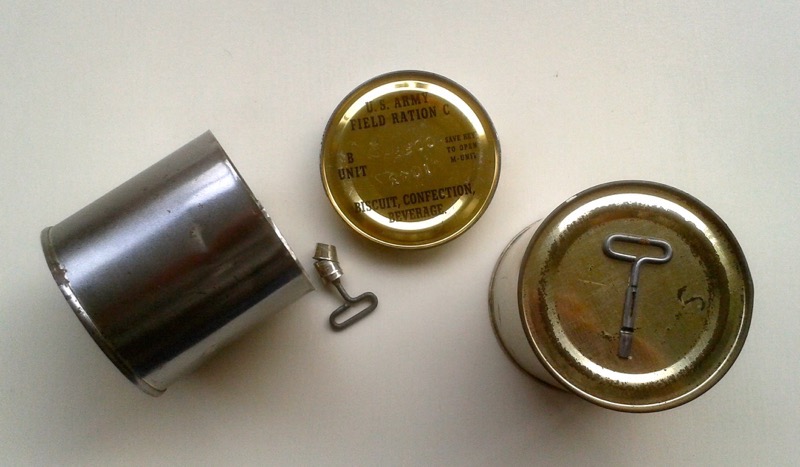
Two B-unit cans are shown here. The B-units can be distinguished from the M-unit by the attached key (right). The M-units did not have an key attached. Note that the body shown left is of an early clear lacquer manufacture mated to a gold lacquered top (middle)
The can had a key style opening. By using a small wire key, a band could be torn from the cans body separating the can in two. The circumference of the body had two scores that went around the body. The key was put over a small lip at the beginning of this band and, by turning the key, the can could be openend. This style of key opening is still used with the truncated corned beef cans.
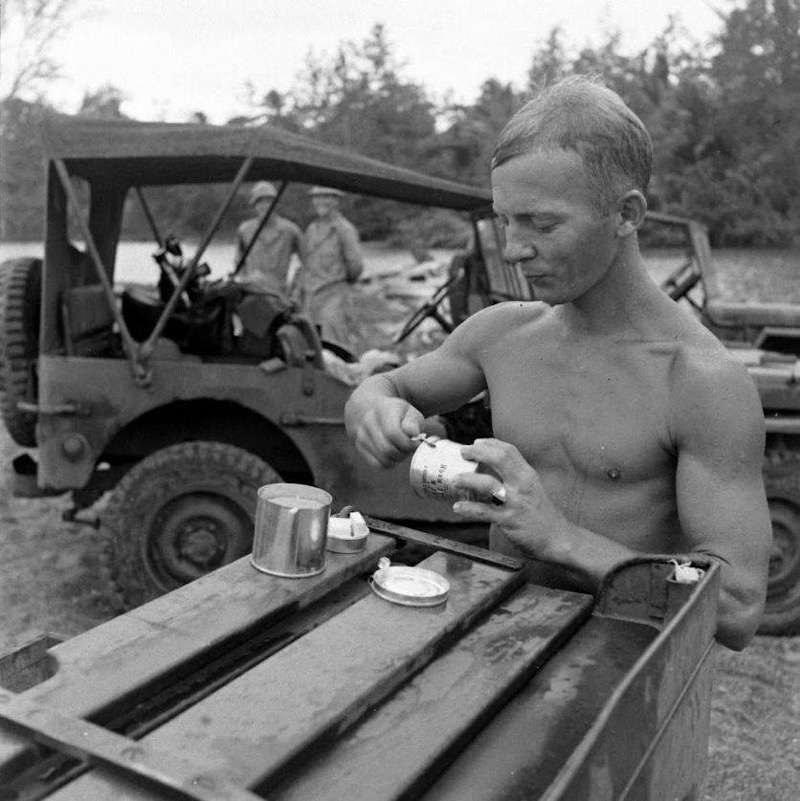
A soldier is openening a can of Meat & Vegetable Hash on Guadalcanal, April 1943.
A drawback of this style of opening is that the contents of the Meat unit would spill since the score was lower than the filling of the can. To try to solve this problem the score was placed higher, but his would weaken the can. During tests the cans with the raised score would burst open when dropped.
Finally the accessory packet was developed containing a small can opener.
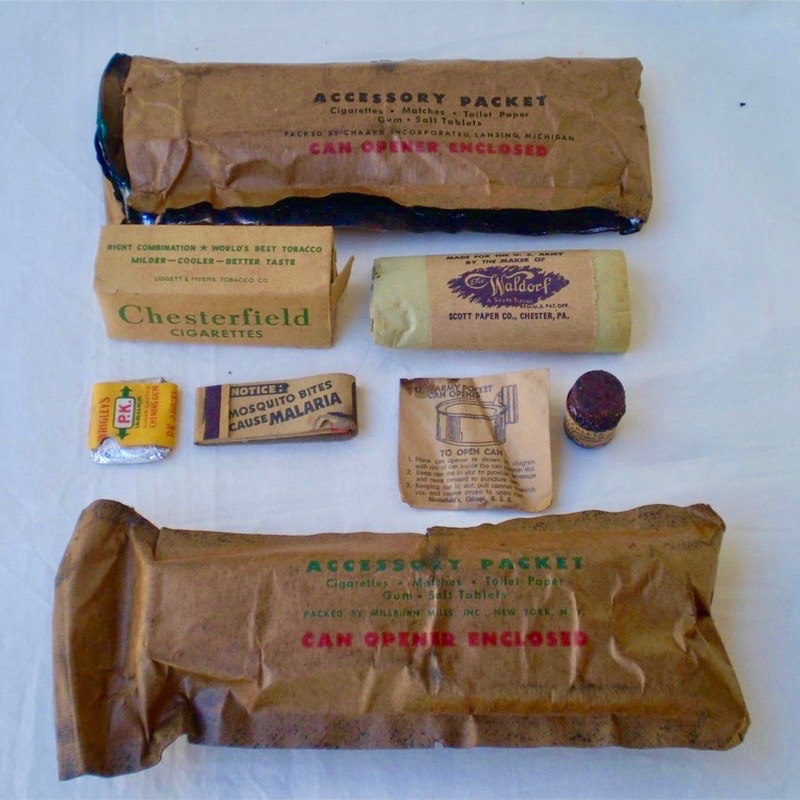
Two accessory packets are shown here with one of the packets opened to show its contents, including the envelope containing the can opener. Note that this is a later version of the packet containing salt tablets instead of the Halazone tablets.
At first both the cans for the M-unit and the B-unit were only tin coated, but since the M-unit was to be washed after filling and closing, a corrosion resisting coating was needed to prevent rusting.

Two opened gold lacquered cans that contained the Meat & Vegetable Stew.
Against regulation the lids are embossed with three lines instead of the approved two. The embossing reads: EST 108, 2293, PM13.
First a clear and later a gold lacquer was used first on the M-unit only, but later on the B-unit as well. In late 1943 it was decided that all cans were to be coated with a non-corrosive olive drab camouflage coating. This was to be done when all existing stock of the clear/gold lacquer coated cans was used up.
From the beginning of the production of the C Ration a list of the contents was lithographed on the body of the can. (Only the experimental cans used paper labels.) This was usually done in black, but either blue, green or red ink was also used.
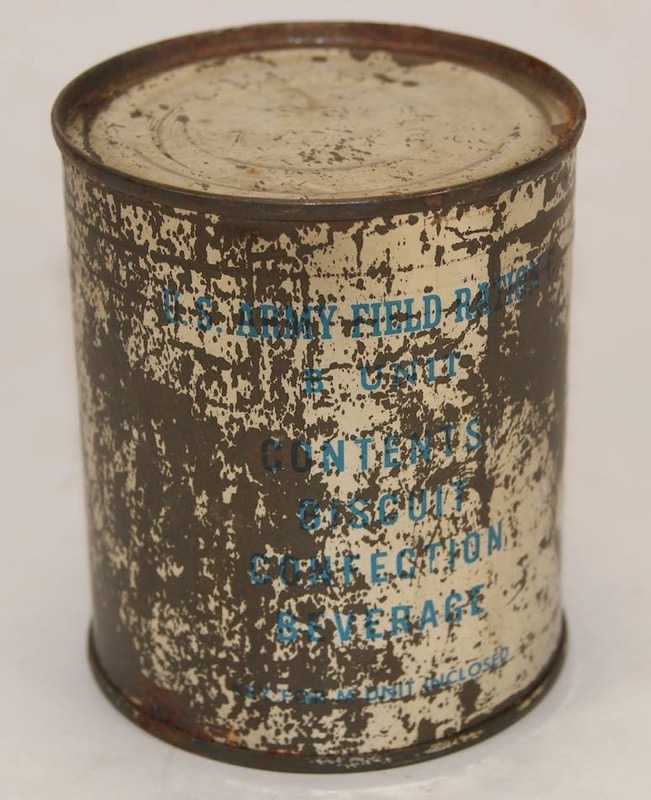
An early produced clear lacquered B-unit with the label lithographed in blue.
Labeling the body of the can had the disadvantage that the can needed to be lifted out from the shipping case in order to identify its contents.
In December 1942 it was decided that for the B-units the label was to be placed on the top end of the can. For the M-unit the label could be either placed on the body of the can, or on one end. At the time of the introduction of the camouflage coated cans all labels were placed on the top end of the can.
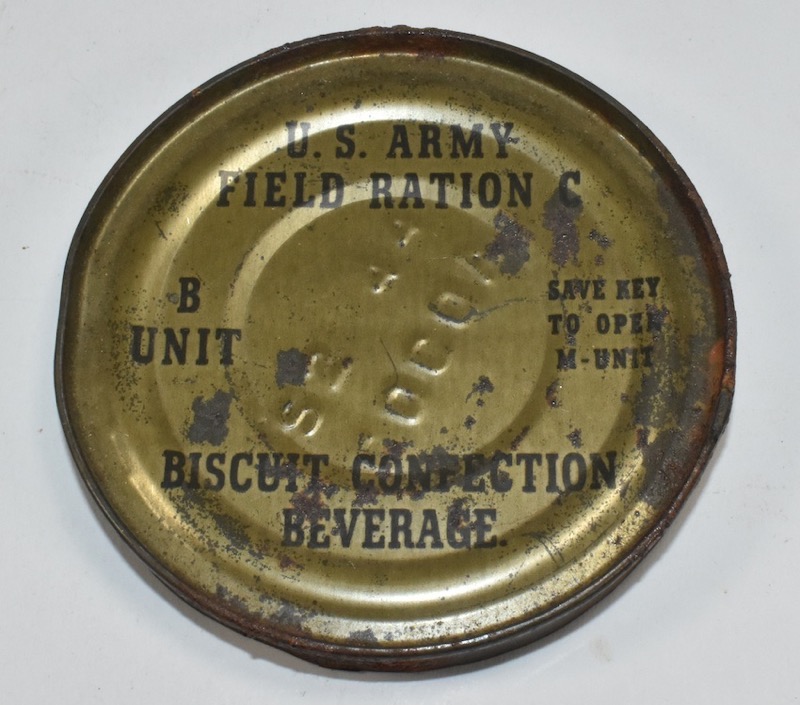
A camouflage lacquered lid of a B-unit produced in 1944. Note that the embossing indicates that cocoa powder is included as a beverage.
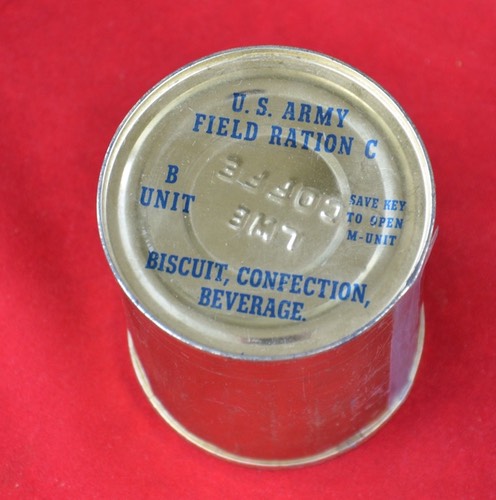
The top that was labeled also carried the embossing of the establishment number of the manufacturer (if not included in the lithographed label) and the month and year of production. As mentioned above, it also contained the embossing of the type of beverage that was included.
Not all cans were embosed with the date and are sometimes embossed with only the (abreviated) name of the prime contractor of the B-units.
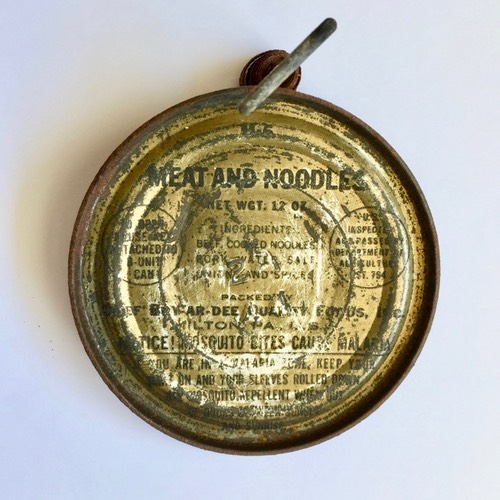
As per specifications of 31 October 1944 a warning against malaria was added to the label of the M-unit (left) and the B-units are labeled with the words BREAKFAST, DINNER or SUPPER in bold letters.
The C Ration now consists of six different B-units and ten different M-units. By matching different B-units with M-units six menus were composed. (see B-unit list in new window)
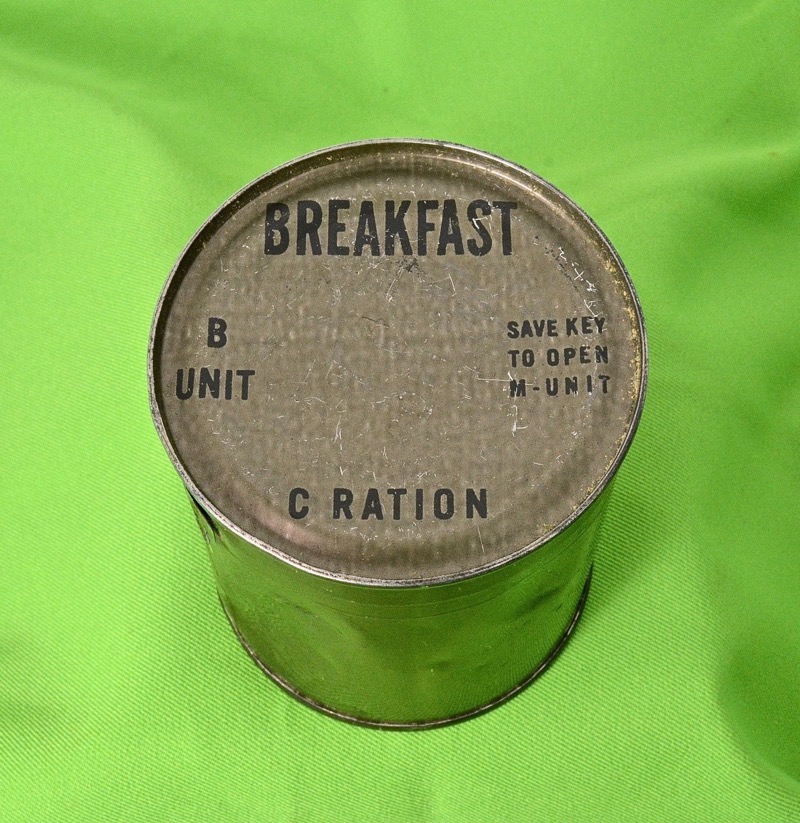
The last version of the C Ration issued during ww2 was of the six menu variety and had the units labeled (Breakfast, Dinner or Supper) accordingly.
The key to open the 15-ounce cans were attached to the top or side by crimping the key to the edge of the can. Often the keys became detached and were lost. With the 12-ounce cans the keys were to be soldered or spot welded to the bottom of the can.
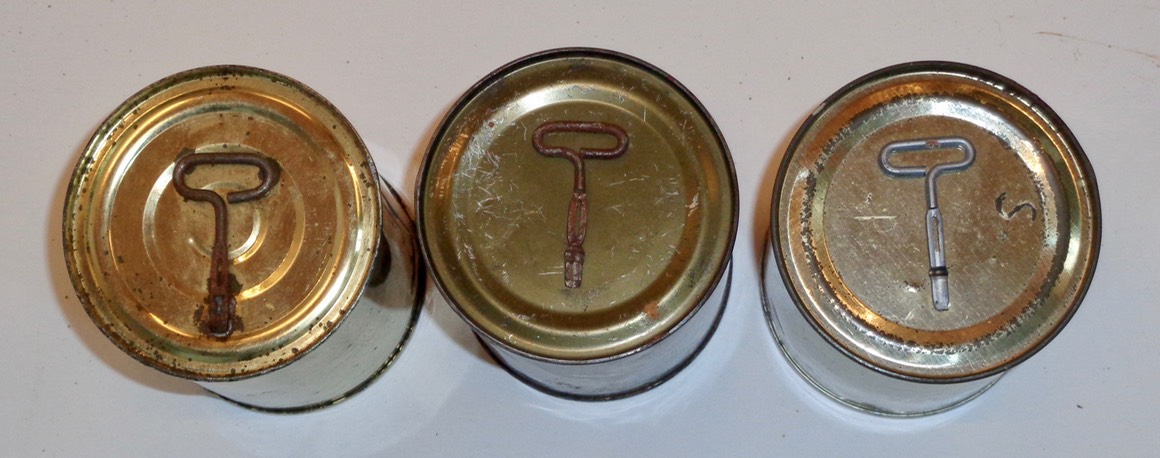
Spotwelding the key to the M-units proved to be a problem since the spotwelding burned through the protective tin coating inside the can. Also, the keys sometimes became detached during the washing operation after filling of the M-unit. Therefor it was decided that the key of the B-unit should also be used for opening the M-unit. This would also be cheaper since half the number of the keys were needed.
That advantage was lost when it was decided that an extra key was to be inserted inside the B-unit in February 1941 (label reads "Key for M-unit enclosed”). In December 1942 this decision was reversed ("Save key to open M-unit”).

Note the instructions for the key to open the M-unit.
Below an example that is strangely without this instruction.
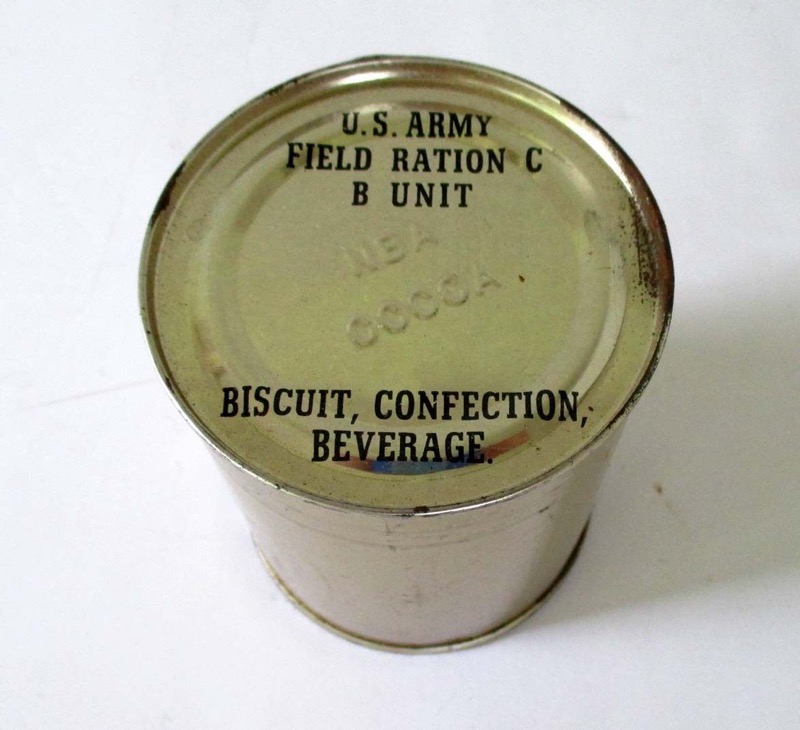
Interestingly, with some of the late war C Rations the keys were sometimes crimped to the top of the cans of the B-units like the early 15-ounce cans. This was perhaps accepted to allow contracts to companies who did’t have the facilities for spot welding and fulfil the ever increasing demand for C Rations.
The possibility to pack the B-unit in a non-metal container was also investigated. Although this would save strategic material and (shipping) weight, the fear for gas contamination and the relaxation on the use of tin as a strategic material ended this experiment. This idea would have made the C Ration practically a K Ration with a more bulky meat product.
Shipping case
One daily ration constituted of six cans. Eight rations were packed in a wooden shipping case. There were four rows of six cans each in the lower tier of the case and four rows on top of these. The two tiers of 24 cans each were separated by a sheet of cardboard early in the war. With the inclusion of the accessory kit the cardboard sheet was deleted because the packets tucked between the cans were as long as two cans are tall.
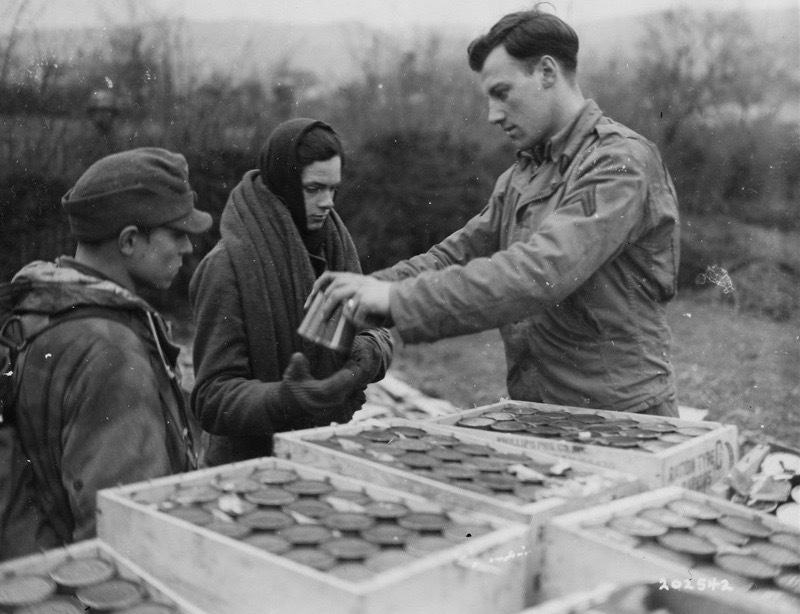
An American corporal is issuing C Rations to German prisoners for their trip to the PoW cage. Note the accessory packets sticking out from between the cans.
By combining the ten meat dishes with the six different B-units, introduced late 1944, six menus were compiled. The four rations in the lower tier were from one menu and the top tier were from another menu. Different packaging companies combined different menus. Eight accessory kits were inserted between the cans. One row of cans and one packet was a complete ration.
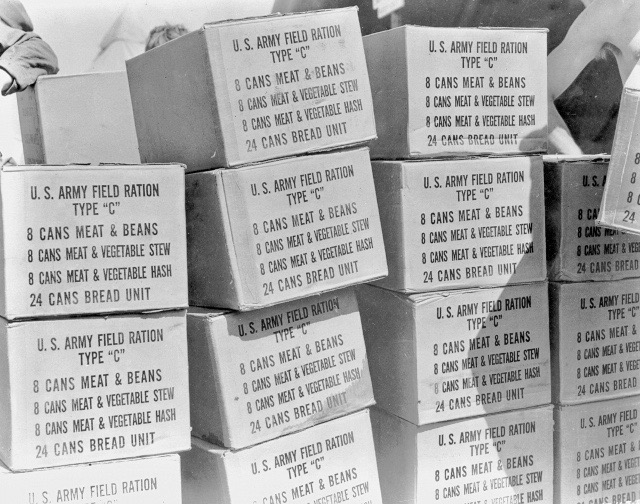
Fiberboard shipping cases used during First Army maneuvers, New York State 1940.
For domestic issue the shipping box was made of solid fiberboard of commercial quality, but for overseas shipping a wooden crate was to be used. These nailed boxes were to be bound with three steel straps. One end of the case was marked with the solid crescent, identifying it as food and the label saying: U.S. Army Field Ration C, 8 Rations, Wt 40 Cu 1.1 (40 pounds and 1.1 cubic feet). Placed on one side panel is the name of the contracter who assembled the ration and contract number plus packaging date as well as the stamp of the inspector.
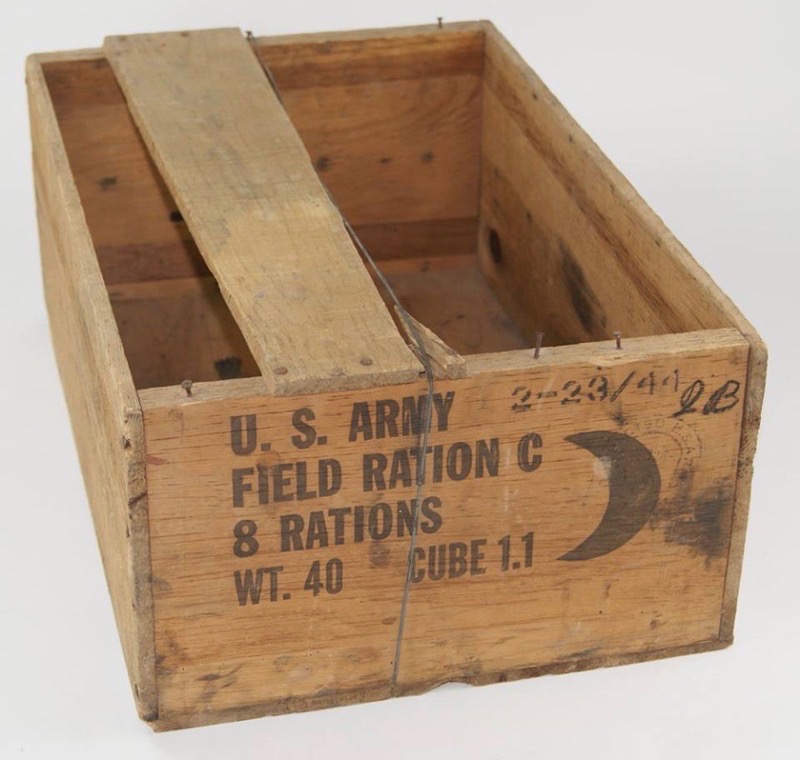
A February 1944 dated crate with one steel wire (referred to as round strap) still running along the long axis of the crate. Note the inspectors stamp over the cresent.
Not all soldiers understood that a complete ration consisted of six cans. Some soldiers were given only three cans as it was understood that one can was one complete meal, other received only B-units or M-units. To solve this problem, a label was stenciled on top of the case saying TOP OPEN HERE, ONE RATION = 1 ROW OF 6 CANS AND 1 PACKET, 3 MEAT & 3 BISCUIT ALL DIFFERENT with an outline indicating one row of six cans. This was instructed in the specifications of June 28, 1944.

Drawing of the label that came with the specifications (top) and the label stamped on a crate dated September 1944 (below)
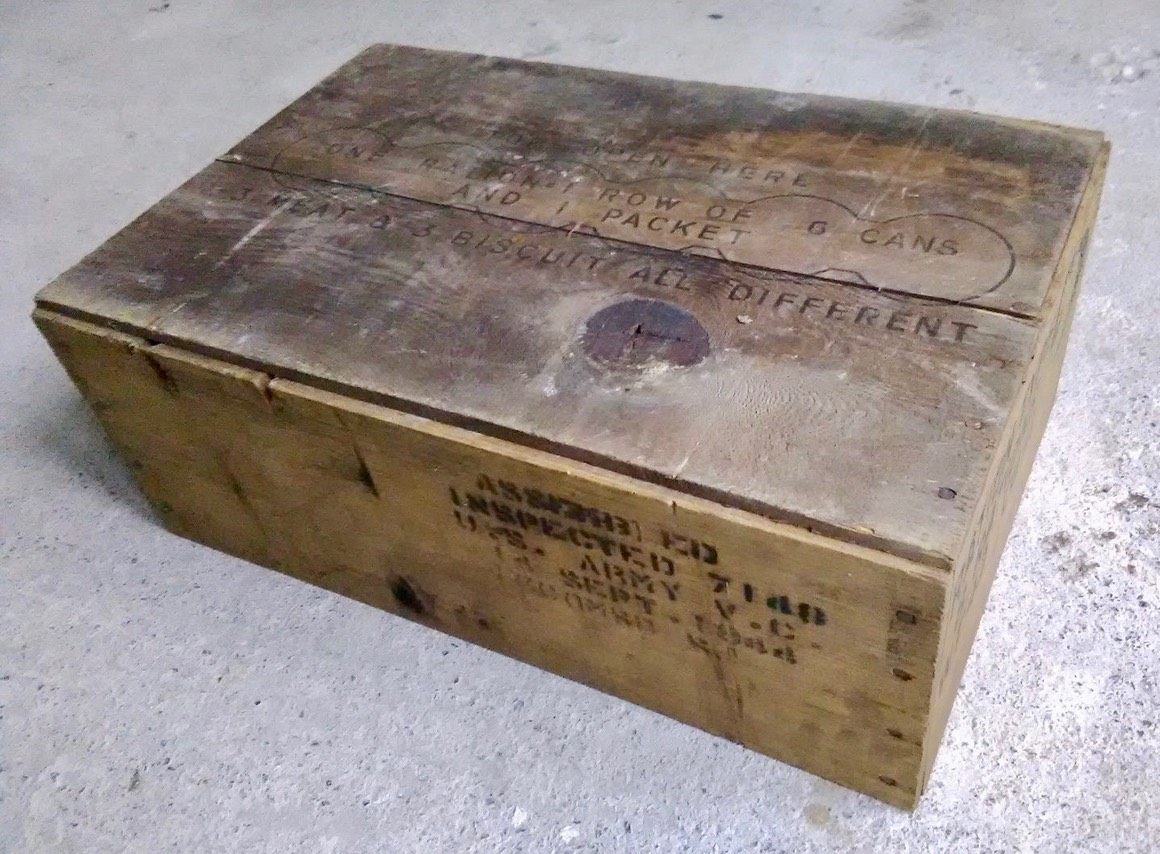
Manufacturers who made only one particular unit (B-unit or M-unit) packed 48 cans of this single unit in a wooden shipping crate that was already labeled with its proper C Ration markings on one end. A sheet of paper was tacked or stapeled to the side of the crate with its temporary contents of those 48 units. The crate was to be closed by taping the lid in place instead of nailing.
At the prime contractor (also called the final assembler) the cans were taken out and the paper label was removed, then the crate was filled with the correct cans to make 8 complete rations (and the accesorry packets inserted). Finally the crate was nailed shut and bounded with steel straps. The contract number, prime contractor and date was then stencilled on the side where the paper label had been.
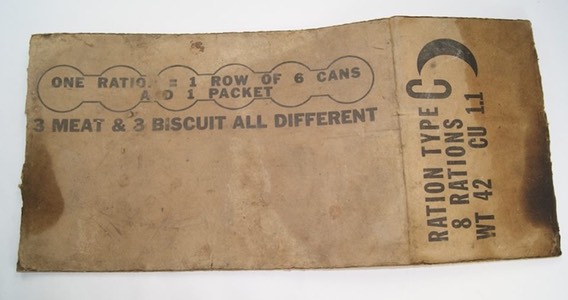
In 1944, as an alternative to the wooden crates, the C rations were packed in a V2 style solid fiberboard carton with sleeve (part of a sleeve is shown right) like the 10-in-1 Ration. These can be seen at the front lines later in the war.
The C Ration conform the 31 October 1944 specifications. Note that the shipping case is the solid fiberboard version. Two rows of the top tiers are exhibited with the B-units and one accessory packet opened showing their contents.
Conclusion
The C Ration was the first serious attempt for a modern palatable emergency ration before the war. It was well received during tests, because it was better than the hardtack, bacon and ground coffee issued prior. It was only intended to replace a missed meal or provide food for one day in the field, but with the mobile warfare introduced in ww2, soldiers would have to subside on it much longer. Sometimes it was the only food available during a campaign (besides the notorious K Ration).
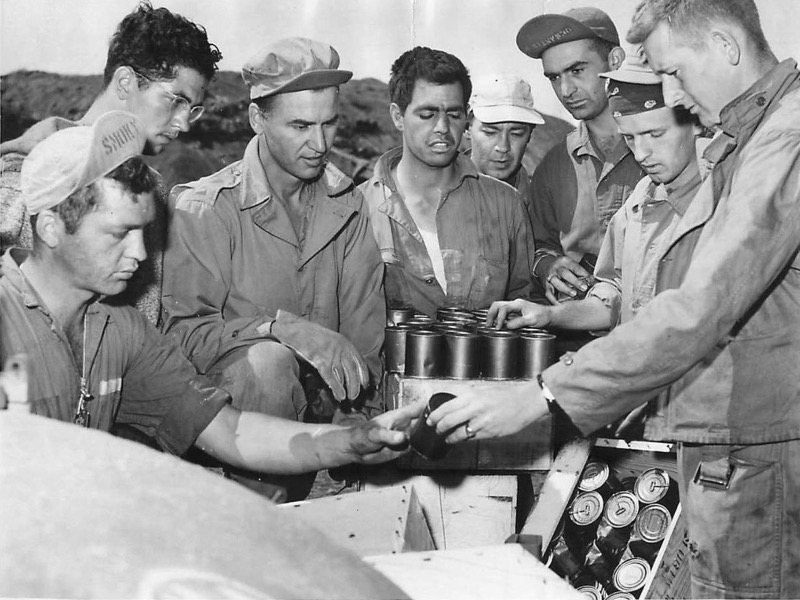
The latest version of the C Ration is handed out to Army Air Force ground personnel on Iwo Jima, 1945. Note that the keys are crimped to the B-units.
The monotony of the three meals was already noted and the search for more varieties continued. However, old stock was issued throughout the war and some men never received the new C Rations. Most veterans only remember the Meat & Beans.
It was also noted that the M-unit would improve a 100% if served hot. Later a small folding cooking stand was developed on which the can could be heated by lighting a heat tablet under it.
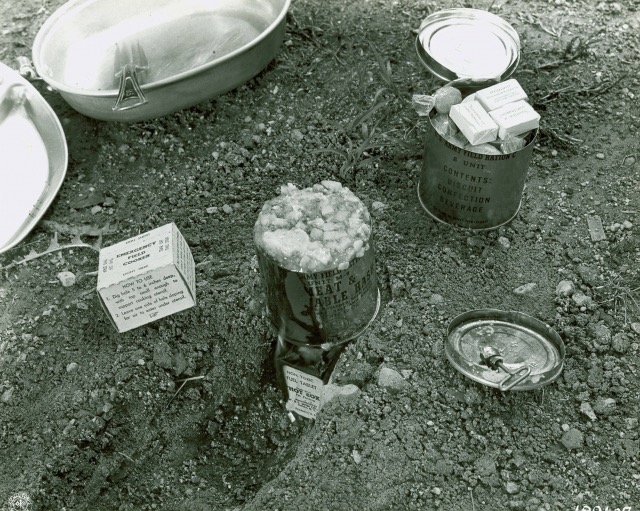
Small heating units (called hot-box) were developed for heating individual rations in the field, but it is doubtfull if these were issued in large quantities at the frontlines.
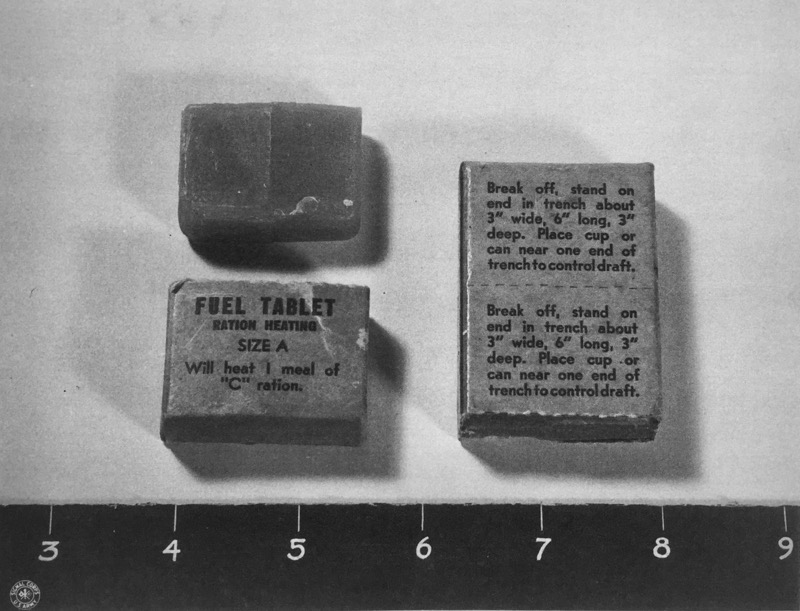
Since it was quite heavy and clumsy to carry in the haversack, the K Ration won in popularity initially. The advantage of the C Ration, however, was that it contained a lot more food, the M-unit would fill the stomach a little more than the K Ration's canned meat or cheese product could. Another advantage was that the M-unit could be heated in it's own container, if there ever was time for that.
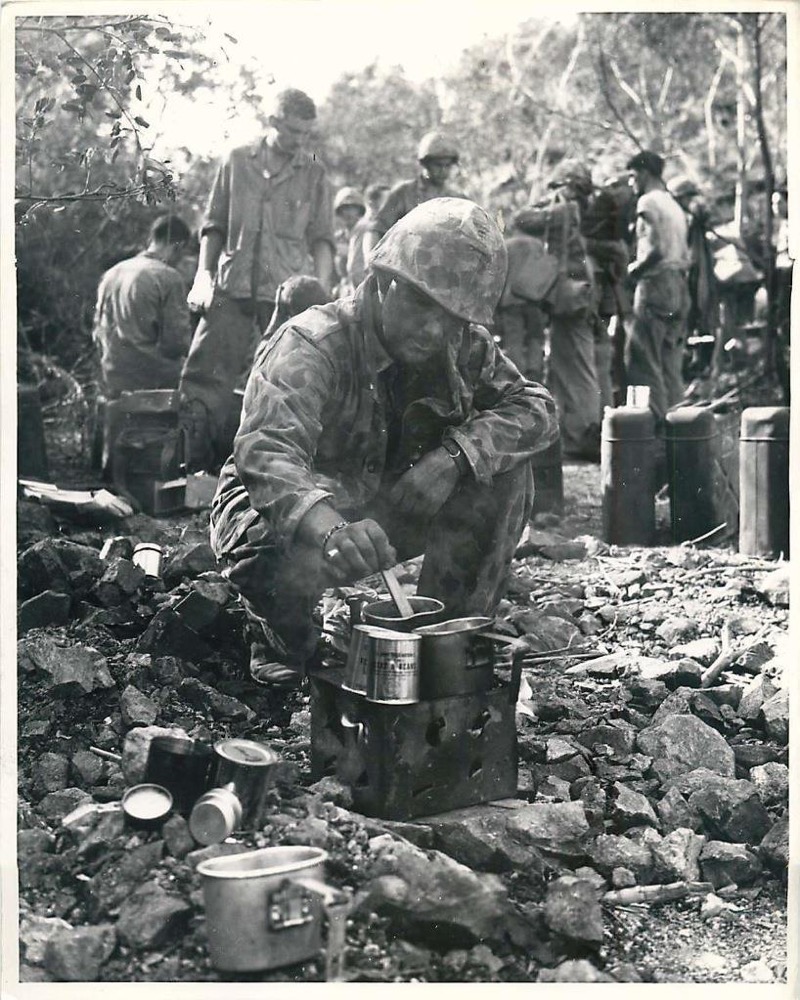
A Marine is heating C Rations on an improvised stove. Two unopened M-units are being heated while the coffee is prepared in two canteen cups at the same time. Saipan, 1944.
Although simpler in use than the K Ration, it turned out that the use of the C Ration during training was still feasible and the use of trainings films was recommended, and acted upon.
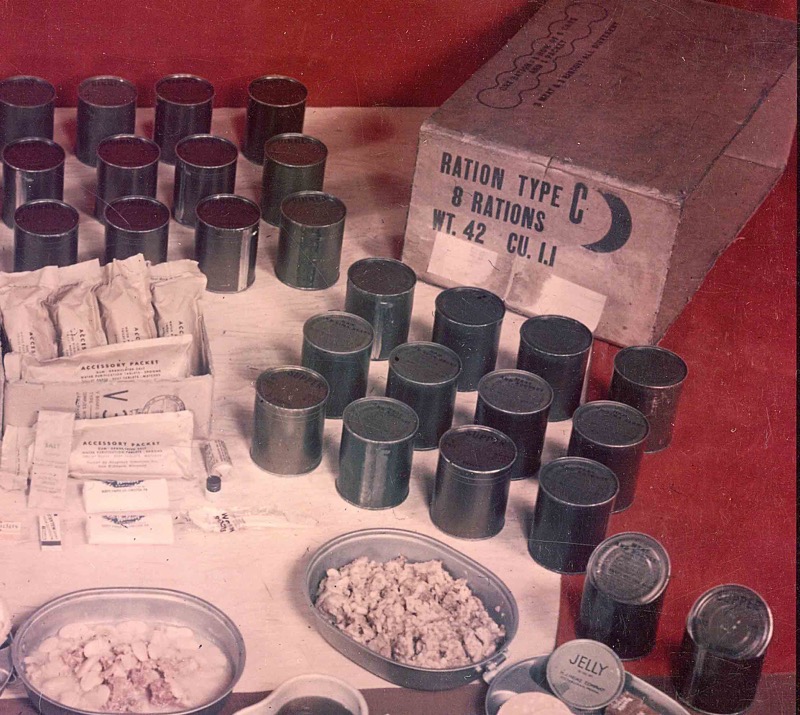
The C Ration in its final (post-war) version. Note that the M-units carry the warning against malaria and the B-units are labeled with the intended meal. The accessory packets are of the latest version containing plastic spoons and heating tablets.
Also, salt is included in both tablet and granulated form.
